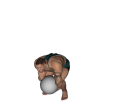 Deadlift - Atlas Stone
Deadlift - Atlas Stone
Benefits: This exercise involves many other muscles.
Purpose: This exercise builds overall strength in the lower body.
Lower Back Glutes Hamstrings Calves Quads Forearms Lats Middle Back Traps Strength Atlas Stone Pull Compound Gym
General Info: The muscles of the lower back straighten the spine. They work together with the abdominals to keep the spine upright. The Barbell Deadlift is considered to be the king of exercises. No other exercise will work your body so much.
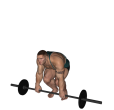 Deadlift - Axle
Deadlift - Axle
Benefits: This exercise involves many other muscles.
Purpose: This exercise builds overall strength in the lower body.
Intermediate Lower Back Glutes Hamstrings Calves Quads Forearms Lats Middle Back Traps Strength Axle Pull Compound Gym
General Info: The muscles of the lower back straighten the spine. They work together with the abdominals to keep the spine upright. The Barbell Deadlift is considered to be the king of exercises. No other exercise will work your body so much.
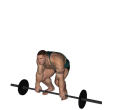 Deadlift - Barbell
Deadlift - Barbell
Benefits: This exercise involves many other muscles.
Purpose: This exercise builds overall strength in the lower body.
Intermediate Lower Back Glutes Hamstrings Calves Quads Forearms Lats Middle Back Traps Strength Barbell Pull Compound Gym
General Info: The muscles of the lower back straighten the spine. They work together with the abdominals to keep the spine upright. The Barbell Deadlift is considered to be the king of exercises. No other exercise will work your body so much.
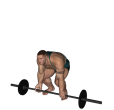 Deadlift - Barbell Mixed Grip
Deadlift - Barbell Mixed Grip
Benefits: This exercise involves many other muscles. The mixed grip allows you to lift heavier weights without worrying about the bar rolling out of your hands.
Purpose: This exercise builds overall strength in the lower body.
Intermediate Lower Back Glutes Hamstrings Calves Quads Forearms Lats Middle Back Traps Strength Barbell Pull Compound Gym
General Info: The muscles of the lower back straighten the spine. They work together with the abdominals to keep the spine upright. The Barbell Deadlift is considered to be the king of exercises. No other exercise will work your body so much.
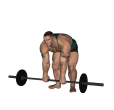 Deadlift - Barbell Straight Leg
Deadlift - Barbell Straight Leg
Benefits: This exercise involves many other muscles.
Purpose: This exercise builds overall strength in the lower body.
Lower Back Glutes Hamstrings Calves Quads Forearms Lats Middle Back Traps Strength Barbell Pull Compound Gym
General Info: The muscles of the lower back straighten the spine. They work together with the abdominals to keep the spine upright. The Barbell Deadlift is considered to be the king of exercises. No other exercise will work your body so much.
 Deadlift - Car
Deadlift - Car
Benefits: This exercise involves many other muscles.
Purpose: This exercise builds overall strength in the lower body.
Lower Back Glutes Hamstrings Calves Quads Forearms Lats Middle Back Traps Strength Car Apparatus Pull Compound Gym
General Info: The muscles of the lower back straighten the spine. They work together with the abdominals to keep the spine upright. The Barbell Deadlift is considered to be the king of exercises. No other exercise will work your body so much.
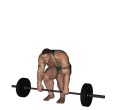 Deadlift - Clean
Deadlift - Clean
Benefits: It is the single best exercise to develop full body strength and increase your fat-burning metabolism.
Purpose: To develop core strength of the lower and middle body.
Intermediate Quads Glutes Hamstrings Calves Lower Back Traps Strength Barbell Push Compound Gym
General Info: The quads are a set of four muscles in the upper front thigh. All four muscles work to straighten the knee. One of the four (rectus femoris) also helps to bend the hip. Squats are considered a vital exercise for increasing the strength and size of the legs and butt.
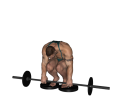 Deadlift - Deficit
Deadlift - Deficit
Benefits: This exercise involves many other muscles.
Purpose: This exercise builds overall strength in the lower body.
Lower Back Glutes Hamstrings Calves Quads Forearms Lats Middle Back Traps Strength Barbell Pull Compound Gym
General Info: The muscles of the lower back straighten the spine. They work together with the abdominals to keep the spine upright. The Barbell Deadlift is considered to be the king of exercises. No other exercise will work your body so much.
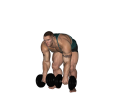 Deadlift - Dumbbell
Deadlift - Dumbbell
Benefits: This exercise involves many other muscles.
Purpose: This exercise builds overall strength in the lower body.
Intermediate Lower Back Glutes Hamstrings Calves Quads Forearms Lats Middle Back Traps Strength Dumbbell Pull Compound Gym
General Info: The muscles of the lower back straighten the spine. They work together with the abdominals to keep the spine upright. The Barbell Deadlift is considered to be the king of exercises. No other exercise will work your body so much.
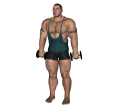 Deadlift - Dumbbell Straight Leg
Deadlift - Dumbbell Straight Leg
Benefits: This exercise involves many other muscles.
Purpose: This exercise builds overall strength in the lower body.
Lower Back Glutes Hamstrings Calves Quads Forearms Lats Middle Back Traps Strength Dumbbell Pull Compound Gym
General Info: The muscles of the lower back straighten the spine. They work together with the abdominals to keep the spine upright. The Barbell Deadlift is considered to be the king of exercises. No other exercise will work your body so much.
 Deadlift - Farmers Walk
Deadlift - Farmers Walk
Benefits: This exercise involves many other muscles.
Purpose: This exercise builds overall strength in the lower body.
Lower Back Glutes Hamstrings Calves Quads Forearms Lats Middle Back Traps Strength Dumbbell Pull Compound Gym
General Info: The muscles of the lower back straighten the spine. They work together with the abdominals to keep the spine upright. The Barbell Deadlift is considered to be the king of exercises. No other exercise will work your body so much.
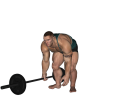 Deadlift - One Arm Side
Deadlift - One Arm Side
Benefits: This exercise involves many other muscles.
Purpose: This exercise builds overall strength in the lower body.
Intermediate Lower Back Glutes Hamstrings Calves Quads Forearms Lats Middle Back Traps Strength Barbell Pull Compound Gym
General Info: The muscles of the lower back straighten the spine. They work together with the abdominals to keep the spine upright. The Barbell Deadlift is considered to be the king of exercises. No other exercise will work your body so much.
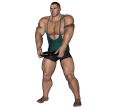 Deadlift - Plate
Deadlift - Plate
Benefits: This exercise involves many other muscles.
Purpose: This exercise builds overall strength in the lower body.
Intermediate Lower Back Glutes Hamstrings Calves Quads Forearms Lats Middle Back Traps Strength Plate Pull Compound Gym
General Info: The muscles of the lower back straighten the spine. They work together with the abdominals to keep the spine upright. The Barbell Deadlift is considered to be the king of exercises. No other exercise will work your body so much.
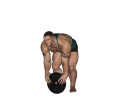 Deadlift - Plate Straight Leg
Deadlift - Plate Straight Leg
Benefits: This exercise involves many other muscles.
Purpose: This exercise builds overall strength in the lower body.
Lower Back Glutes Hamstrings Calves Quads Forearms Lats Middle Back Traps Strength Plate Pull Compound Gym
General Info: The muscles of the lower back straighten the spine. They work together with the abdominals to keep the spine upright. The Barbell Deadlift is considered to be the king of exercises. No other exercise will work your body so much.
 Deadlift - Power Stairs
Deadlift - Power Stairs
Benefits: This exercise involves many other muscles.
Purpose: This exercise builds overall strength in the lower body.
Lower Back Glutes Hamstrings Calves Quads Forearms Lats Middle Back Traps Strength Dumbbell Pull Compound Gym
General Info: The muscles of the lower back straighten the spine. They work together with the abdominals to keep the spine upright. The Barbell Deadlift is considered to be the king of exercises. No other exercise will work your body so much.
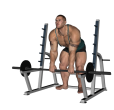 Deadlift - Rack Pull
Deadlift - Rack Pull
Benefits: This exercise involves many other muscles.
Purpose: This exercise builds overall strength in the lower body.
Intermediate Lower Back Glutes Hamstrings Calves Quads Forearms Lats Middle Back Traps Strength Power Rack Barbell Pull Compound Gym
General Info: The muscles of the lower back straighten the spine. They work together with the abdominals to keep the spine upright. The Barbell Deadlift is considered to be the king of exercises. No other exercise will work your body so much.
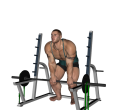 Deadlift - Rack Pull With Bands
Deadlift - Rack Pull With Bands
Benefits: This exercise involves many other muscles.
Purpose: This exercise builds overall strength in the lower body.
Intermediate Lower Back Glutes Hamstrings Calves Quads Forearms Lats Middle Back Traps Strength Power Rack Barbell Band Pull Compound Gym
General Info: The muscles of the lower back straighten the spine. They work together with the abdominals to keep the spine upright. The Barbell Deadlift is considered to be the king of exercises. No other exercise will work your body so much.
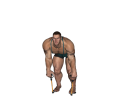 Deadlift - Resistance Tube Straight Leg
Deadlift - Resistance Tube Straight Leg
Benefits: This exercise involves many other muscles.
Purpose: This exercise builds overall strength in the lower body.
Beginner Lower Back Glutes Hamstrings Calves Quads Forearms Lats Middle Back Traps Strength Resistance Tube Pull Compound Gym
General Info: The muscles of the lower back straighten the spine. They work together with the abdominals to keep the spine upright. The Barbell Deadlift is considered to be the king of exercises. No other exercise will work your body so much.
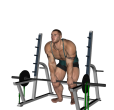 Deadlift - Reverse Band
Deadlift - Reverse Band
Benefits: This exercise involves many other muscles.
Purpose: This exercise builds overall strength in the lower body.
Intermediate Lower Back Glutes Hamstrings Calves Quads Forearms Lats Middle Back Traps Strength Power Rack Barbell Band Pull Compound Gym
General Info: The muscles of the lower back straighten the spine. They work together with the abdominals to keep the spine upright. The Barbell Deadlift is considered to be the king of exercises. No other exercise will work your body so much.
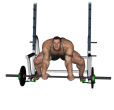 Deadlift - Reverse Band Sumo
Deadlift - Reverse Band Sumo
Benefits: This exercise involves many other muscles.
Purpose: This exercise builds overall strength in the lower body.
Intermediate Lower Back Glutes Hamstrings Calves Quads Forearms Lats Middle Back Traps Strength Power Rack Barbell Band Pull Compound Gym
General Info: The muscles of the lower back straighten the spine. They work together with the abdominals to keep the spine upright. The Barbell Deadlift is considered to be the king of exercises. No other exercise will work your body so much.
 Deadlift - Rickshaw
Deadlift - Rickshaw
Benefits: This exercise involves many other muscles.
Purpose: This exercise builds overall strength in the lower body.
Lower Back Glutes Hamstrings Calves Quads Forearms Lats Middle Back Traps Strength Rickshaw Apparatus Pull Compound Gym
General Info: The muscles of the lower back straighten the spine. They work together with the abdominals to keep the spine upright. The Barbell Deadlift is considered to be the king of exercises. No other exercise will work your body so much.
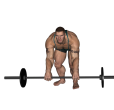 Deadlift - Romanian
Deadlift - Romanian
Benefits: This exercise involves many other muscles.
Purpose: This exercise builds overall strength in the lower body.
Lower Back Glutes Hamstrings Calves Quads Forearms Lats Middle Back Traps Strength Barbell Pull Compound Gym
General Info: The muscles of the lower back straighten the spine. They work together with the abdominals to keep the spine upright. The Barbell Deadlift is considered to be the king of exercises. No other exercise will work your body so much.
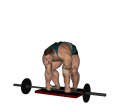 Deadlift - Romanian From Deficit
Deadlift - Romanian From Deficit
Benefits: This exercise involves many other muscles.
Purpose: This exercise builds overall strength in the lower body.
Lower Back Glutes Hamstrings Calves Quads Forearms Lats Middle Back Traps Strength Barbell Pull Compound Gym
General Info: The muscles of the lower back straighten the spine. They work together with the abdominals to keep the spine upright. The Barbell Deadlift is considered to be the king of exercises. No other exercise will work your body so much.
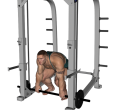 Deadlift - Smith Machine
Deadlift - Smith Machine
Benefits: This exercise involves many other muscles.
Purpose: This exercise builds overall strength in the lower body.
Intermediate Lower Back Glutes Hamstrings Calves Quads Forearms Lats Middle Back Traps Strength Smith Machine Pull Compound Gym
General Info: The muscles of the lower back straighten the spine. They work together with the abdominals to keep the spine upright. The Barbell Deadlift is considered to be the king of exercises. No other exercise will work your body so much.
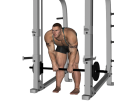 Deadlift - Smith Machine Stiff Legged
Deadlift - Smith Machine Stiff Legged
Benefits: This exercise involves many other muscles.
Purpose: This exercise builds overall strength in the lower body.
Lower Back Glutes Hamstrings Calves Quads Forearms Lats Middle Back Traps Strength Smith Machine Pull Compound Gym
General Info: The muscles of the lower back straighten the spine. They work together with the abdominals to keep the spine upright. The Barbell Deadlift is considered to be the king of exercises. No other exercise will work your body so much.
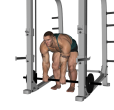 Deadlift - Smith Machine Straight Leg
Deadlift - Smith Machine Straight Leg
Benefits: This exercise involves many other muscles.
Purpose: This exercise builds overall strength in the lower body.
Lower Back Glutes Hamstrings Calves Quads Forearms Lats Middle Back Traps Strength Smith Machine Pull Compound Gym
General Info: The muscles of the lower back straighten the spine. They work together with the abdominals to keep the spine upright. The Barbell Deadlift is considered to be the king of exercises. No other exercise will work your body so much.
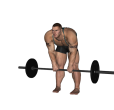 Deadlift - Stiff Legged Barbell
Deadlift - Stiff Legged Barbell
Benefits: This exercise involves many other muscles.
Purpose: This exercise builds overall strength in the lower body.
Lower Back Glutes Hamstrings Calves Quads Forearms Lats Middle Back Traps Strength Barbell Pull Compound Gym
General Info: The muscles of the lower back straighten the spine. They work together with the abdominals to keep the spine upright. The Barbell Deadlift is considered to be the king of exercises. No other exercise will work your body so much.
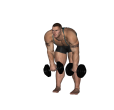 Deadlift - Stiff Legged Dumbbell
Deadlift - Stiff Legged Dumbbell
Benefits: This exercise involves many other muscles.
Purpose: This exercise builds overall strength in the lower body.
Lower Back Glutes Hamstrings Calves Quads Forearms Lats Middle Back Traps Strength Dumbbell Pull Compound Gym
General Info: The muscles of the lower back straighten the spine. They work together with the abdominals to keep the spine upright. The Barbell Deadlift is considered to be the king of exercises. No other exercise will work your body so much.
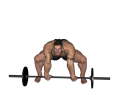 Deadlift - Sumo
Deadlift - Sumo
Benefits: This exercise involves many other muscles.
Purpose: This exercise builds overall strength in the lower body.
Intermediate Lower Back Glutes Hamstrings Calves Quads Forearms Lats Middle Back Traps Strength Barbell Pull Compound Gym
General Info: The muscles of the lower back straighten the spine. They work together with the abdominals to keep the spine upright. The Barbell Deadlift is considered to be the king of exercises. No other exercise will work your body so much.
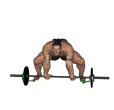 Deadlift - Sumo With Bands
Deadlift - Sumo With Bands
Benefits: This exercise involves many other muscles.
Purpose: This exercise builds overall strength in the lower body.
Intermediate Lower Back Glutes Hamstrings Calves Quads Forearms Lats Middle Back Traps Strength Barbell Band Pull Compound Gym
General Info: The muscles of the lower back straighten the spine. They work together with the abdominals to keep the spine upright. The Barbell Deadlift is considered to be the king of exercises. No other exercise will work your body so much.
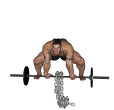 Deadlift - Sumo With Chains
Deadlift - Sumo With Chains
Benefits: This exercise is done with the addition of chains. The primary function of chains is to accommodate resistance. Chains are also a great means of weight loading (adding more weight to an exercise). Chains are also a great way for working the stabilizers.
Purpose: Benefits This exercise involves many other muscles.
Intermediate Lower Back Glutes Hamstrings Calves Quads Forearms Lats Middle Back Traps Strength Barbell Chains Pull Compound Gym
General Info: The muscles of the lower back straighten the spine. They work together with the abdominals to keep the spine upright. The Barbell Deadlift is considered to be the king of exercises. No other exercise will work your body so much.
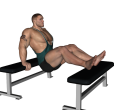 Dip - Bench
Dip - Bench
Benefits: .
Purpose: Benefits Strengthening the triceps balances the biceps muscle.
Beginner Triceps Shoulders Strength Flat Bench Push Compound Gym
General Info: The triceps is a straight muscle with three heads, long head (which extends and adducts the shoulder joint), lateral head (outer triceps) and medial head (inner head along with the long head).
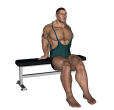 Dip - Bench Bent Knee
Dip - Bench Bent Knee
Benefits: .
Purpose: Benefits Strengthening the triceps balances the biceps muscle.
Beginner Triceps Shoulders Strength Flat Bench Push Compound Gym
General Info: The triceps is a straight muscle with three heads, long head (which extends and adducts the shoulder joint), lateral head (outer triceps) and medial head (inner head along with the long head).
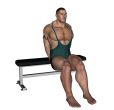 Dip - Bench Bent Knee Close Grip
Dip - Bench Bent Knee Close Grip
Benefits: .
Purpose: Benefits Strengthening the triceps balances the biceps muscle.
Beginner Triceps Shoulders Strength Flat Bench Push Compound Gym
General Info: The triceps is a straight muscle with three heads, long head (which extends and adducts the shoulder joint), lateral head (outer triceps) and medial head (inner head along with the long head).
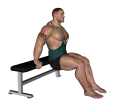 Dip - Bench Bent Knee Wide Grip
Dip - Bench Bent Knee Wide Grip
Benefits: .
Purpose: Benefits Strengthening the triceps balances the biceps muscle.
Beginner Triceps Shoulders Strength Flat Bench Push Compound Gym
General Info: The triceps is a straight muscle with three heads, long head (which extends and adducts the shoulder joint), lateral head (outer triceps) and medial head (inner head along with the long head).
 Dip - Chair
Dip - Chair
Benefits: .
Purpose: Benefits Strengthening the triceps balances the biceps muscle.
Beginner Triceps Shoulders Strength Chair Push Compound Home
General Info: The triceps is a straight muscle with three heads, long head (which extends and adducts the shoulder joint), lateral head (outer triceps) and medial head (inner head along with the long head).
 Dip - Chair Bent Knee
Dip - Chair Bent Knee
Benefits: .
Purpose: Benefits Strengthening the triceps balances the biceps muscle.
Beginner Triceps Shoulders Strength Chair Push Compound Home
General Info: The triceps is a straight muscle with three heads, long head (which extends and adducts the shoulder joint), lateral head (outer triceps) and medial head (inner head along with the long head).
 Dip - Chair Bent Knee Close Grip
Dip - Chair Bent Knee Close Grip
Benefits: .
Purpose: Benefits Strengthening the triceps balances the biceps muscle.
Beginner Triceps Shoulders Strength Chair Push Compound Home
General Info: The triceps is a straight muscle with three heads, long head (which extends and adducts the shoulder joint), lateral head (outer triceps) and medial head (inner head along with the long head).
 Dip - Chair Bent Knee Wide Grip
Dip - Chair Bent Knee Wide Grip
Benefits: .
Purpose: Benefits Strengthening the triceps balances the biceps muscle.
Beginner Triceps Shoulders Strength Chair Push Compound Home
General Info: The triceps is a straight muscle with three heads, long head (which extends and adducts the shoulder joint), lateral head (outer triceps) and medial head (inner head along with the long head).
 Dip - Chair Leg Raised Floor
Dip - Chair Leg Raised Floor
Benefits: .
Purpose: Benefits Strengthening the triceps balances the biceps muscle.
Beginner Triceps Shoulders Strength Chair Push Compound Home
General Info: The triceps is a straight muscle with three heads, long head (which extends and adducts the shoulder joint), lateral head (outer triceps) and medial head (inner head along with the long head).
 Dip - Chair Leg Raised Floor Close Grip
Dip - Chair Leg Raised Floor Close Grip
Benefits: .
Purpose: Benefits Strengthening the triceps balances the biceps muscle.
Beginner Triceps Shoulders Strength Chair Push Compound Home
General Info: The triceps is a straight muscle with three heads, long head (which extends and adducts the shoulder joint), lateral head (outer triceps) and medial head (inner head along with the long head).
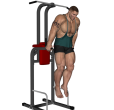 Dip - Chest
Dip - Chest
Benefits: This exercise isolates the section of the pecs along the sternum.
Purpose: This exercise the action of the pecs pulling across the chest, especially focused on the middle pecs.
Beginner Chest Strength Dipping Bars Push Gym
General Info: The chest is composed of the Pectoralis Major and the Pectoralis Minor. The Pec Major attaches to the upper arm and pulls the upper arm across the chest. The Pec Minor lies mostly underneath the Pec Major and draws the shoulder blade down and forward.
 Dip - Chest With Chains
Dip - Chest With Chains
Benefits: This exercise is done with the addition of chains. The primary function of chains is to accommodate resistance. Chains are also a great means of weight loading (adding more weight to an exercise). Chains are also a great way for working the stabilizers.
Purpose: Benefits This exercise isolates the section of the pecs along the sternum.
Beginner Chest Strength Dipping Bars Chains Push Gym
General Info: The chest is composed of the Pectoralis Major and the Pectoralis Minor. The Pec Major attaches to the upper arm and pulls the upper arm across the chest. The Pec Minor lies mostly underneath the Pec Major and draws the shoulder blade down and forward.
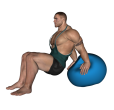 Dip - Fitness Ball Bent Knee
Dip - Fitness Ball Bent Knee
Benefits: .
Purpose: Benefits Strengthening the triceps balances the biceps muscle.
Beginner Triceps Shoulders Strength Fitness Ball Push Compound Gym
General Info: The triceps is a straight muscle with three heads, long head (which extends and adducts the shoulder joint), lateral head (outer triceps) and medial head (inner head along with the long head).
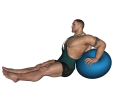 Dip - Fitness Ball Straight Leg
Dip - Fitness Ball Straight Leg
Benefits: Strengthening the triceps balances the biceps muscle.
Purpose: This exercise strengthens the triceps muscle.
Beginner Triceps Shoulders Strength Fitness Ball Push Compound Gym
General Info: The triceps is a straight muscle with three heads, long head (which extends and adducts the shoulder joint), lateral head (outer triceps) and medial head (inner head along with the long head).
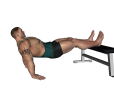 Dip - Leg Raised Floor
Dip - Leg Raised Floor
Benefits: Strengthening the triceps balances the biceps muscle.
Purpose: This exercise strengthens the triceps muscle.
Beginner Triceps Shoulders Strength Flat Bench Push Compound Gym
General Info: The triceps is a straight muscle with three heads, long head (which extends and adducts the shoulder joint), lateral head (outer triceps) and medial head (inner head along with the long head).
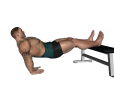 Dip - Leg Raised Floor Close Grip
Dip - Leg Raised Floor Close Grip
Benefits: Strengthening the triceps balances the biceps muscle.
Purpose: This exercise strengthens the triceps muscle.
Beginner Triceps Shoulders Strength Flat Bench Push Compound Gym
General Info: The triceps is a straight muscle with three heads, long head (which extends and adducts the shoulder joint), lateral head (outer triceps) and medial head (inner head along with the long head).
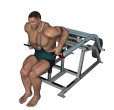 Dip - Machine
Dip - Machine
Benefits: Strengthening the triceps balances the biceps muscle.
Purpose: This exercise strengthens the triceps muscle.
Beginner Triceps Shoulders Strength Dip Machine Push Compound Gym
General Info: The triceps is a straight muscle with three heads, long head (which extends and adducts the shoulder joint), lateral head (outer triceps) and medial head (inner head along with the long head).
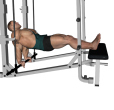 Dip - Smith Machine
Dip - Smith Machine
Benefits: Strengthening the triceps balances the biceps muscle.
Purpose: This exercise strengthens the triceps muscle.
Beginner Triceps Shoulders Strength Smith Machine Flat Bench Push Compound Gym
General Info: The triceps is a straight muscle with three heads, long head (which extends and adducts the shoulder joint), lateral head (outer triceps) and medial head (inner head along with the long head).
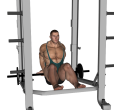 Dip - Smith Machine Bent Knee
Dip - Smith Machine Bent Knee
Benefits: .
Purpose: Benefits Strengthening the triceps balances the biceps muscle.
Beginner Triceps Shoulders Strength Smith Machine Push Compound Gym
General Info: The triceps is a straight muscle with three heads, long head (which extends and adducts the shoulder joint), lateral head (outer triceps) and medial head (inner head along with the long head).
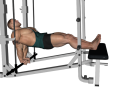 Dip - Smith Machine Close Grip
Dip - Smith Machine Close Grip
Benefits: Strengthening the triceps balances the biceps muscle.
Purpose: This exercise strengthens the triceps muscle.
Beginner Triceps Shoulders Strength Smith Machine Flat Bench Push Compound Gym
General Info: The triceps is a straight muscle with three heads, long head (which extends and adducts the shoulder joint), lateral head (outer triceps) and medial head (inner head along with the long head).
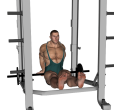 Dip - Smith Machine Straight Leg
Dip - Smith Machine Straight Leg
Benefits: .
Purpose: Benefits Strengthening the triceps balances the biceps muscle.
Beginner Triceps Shoulders Strength Smith Machine Push Compound Gym
General Info: The triceps is a straight muscle with three heads, long head (which extends and adducts the shoulder joint), lateral head (outer triceps) and medial head (inner head along with the long head).
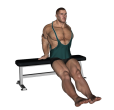 Dip - Straight Leg Bench
Dip - Straight Leg Bench
Benefits: Strengthening the triceps balances the biceps muscle.
Purpose: This exercise strengthens the triceps muscle.
Beginner Triceps Shoulders Strength Flat Bench Push Compound Gym
General Info: The triceps is a straight muscle with three heads, long head (which extends and adducts the shoulder joint), lateral head (outer triceps) and medial head (inner head along with the long head).
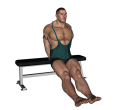 Dip - Straight Leg Bench Close Grip
Dip - Straight Leg Bench Close Grip
Benefits: .
Purpose: Benefits Strengthening the triceps balances the biceps muscle.
Beginner Triceps Shoulders Strength Flat Bench Push Compound Gym
General Info: The triceps is a straight muscle with three heads, long head (which extends and adducts the shoulder joint), lateral head (outer triceps) and medial head (inner head along with the long head).
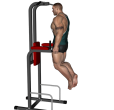 Dip - Triceps
Dip - Triceps
Benefits: Strengthening the triceps balances the biceps muscle.
Purpose: This exercise strengthens the triceps muscle.
Beginner Triceps Shoulders Strength Dipping Bars Push Compound Gym
General Info: The triceps is a straight muscle with three heads, long head (which extends and adducts the shoulder joint), lateral head (outer triceps) and medial head (inner head along with the long head).
 Dip - Triceps With Chains
Dip - Triceps With Chains
Benefits: This exercise is done with the addition of chains. The primary function of chains is to accommodate resistance. Chains are also a great means of weight loading (adding more weight to an exercise). Chains are also a great way for working the stabilizers.
Purpose: .
Beginner Triceps Shoulders Strength Dipping Bars Chains Push Compound Gym
General Info: The triceps is a straight muscle with three heads, long head (which extends and adducts the shoulder joint), lateral head (outer triceps) and medial head (inner head along with the long head).
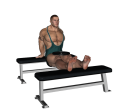 Dip - Weighted Bench
Dip - Weighted Bench
Benefits: .
Purpose: Benefits Strengthening the triceps balances the biceps muscle.
Beginner Triceps Shoulders Strength Flat Bench Plate Push Compound Gym
General Info: The triceps is a straight muscle with three heads, long head (which extends and adducts the shoulder joint), lateral head (outer triceps) and medial head (inner head along with the long head).
 Dip - Weighted Chair
Dip - Weighted Chair
Benefits: .
Purpose: Benefits Strengthening the triceps balances the biceps muscle.
Beginner Triceps Shoulders Strength Chair Book Push Compound Home
General Info: The triceps is a straight muscle with three heads, long head (which extends and adducts the shoulder joint), lateral head (outer triceps) and medial head (inner head along with the long head).
 Drag - Backward
Drag - Backward
Benefits: It is the single best exercise to develop full body strength and increase your fat-burning metabolism.
Purpose: To develop core strength of the lower and middle body.
Intermediate Quads Lower Back Strength Sled Push Compound Gym
General Info: The quads are a set of four muscles in the upper front thigh. All four muscles work to straighten the knee. One of the four (rectus femoris) also helps to bend the hip. Squats are considered a vital exercise for increasing the strength and size of the legs and butt.
 Drag - Forward With Press
Drag - Forward With Press
Benefits: It is the single best exercise to develop full body strength and increase your fat-burning metabolism.
Purpose: To develop core strength of the lower and middle body.
Intermediate Quads Triceps Chest Strength Sled Push Compound Gym
General Info: The quads are a set of four muscles in the upper front thigh. All four muscles work to straighten the knee. One of the four (rectus femoris) also helps to bend the hip. Squats are considered a vital exercise for increasing the strength and size of the legs and butt.
 Drag - Sled Harness
Drag - Sled Harness
Benefits: It is the single best exercise to develop full body strength and increase your fat-burning metabolism.
Purpose: To develop core strength of the lower and middle body.
Intermediate Quads Hamstrings Strength Sled Push Compound Gym
General Info: The quads are a set of four muscles in the upper front thigh. All four muscles work to straighten the knee. One of the four (rectus femoris) also helps to bend the hip. Squats are considered a vital exercise for increasing the strength and size of the legs and butt.
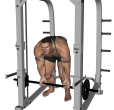 Drag Curl - Smith Machine Bent Over
Drag Curl - Smith Machine Bent Over
Benefits: This exercise works both heads of the biceps with a heavier weight than can typically be done with dumbbells.
Purpose: This exercise is used to target the biceps muscle to develop size, definition, strength, endurance and power.
Intermediate Biceps Forearms Shoulders Lower Back Strength Smith Machine Pull Compound Gym
General Info: The biceps is a straight muscle with two heads. The long head of the biceps crosses both the elbow and the shoulder joint. It bends the elbow and raises the arm forward at the shoulder. The short head crosses the elbow joint and, in conjunction with the brachioradialis, supinates the hand.
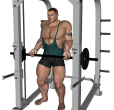 Drag Curl - Smith Machine Standing
Drag Curl - Smith Machine Standing
Benefits: This exercise works both heads of the biceps with a heavier weight than can typically be done with dumbbells.
Purpose: This exercise is used to target the biceps muscle to develop size, definition, strength, endurance and power.
Intermediate Biceps Forearms Shoulders Strength Smith Machine Pull Compound Gym
General Info: The biceps is a straight muscle with two heads. The long head of the biceps crosses both the elbow and the shoulder joint. It bends the elbow and raises the arm forward at the shoulder. The short head crosses the elbow joint and, in conjunction with the brachioradialis, supinates the hand.
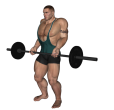 Drag Curl - Standing Barbell
Drag Curl - Standing Barbell
Benefits: This exercise works both heads of the biceps with a heavier weight than can typically be done with dumbbells.
Purpose: This exercise is used to target the biceps muscle to develop size, definition, strength, endurance and power.
Intermediate Biceps Forearms Shoulders Strength Barbell Pull Compound Gym
General Info: The biceps is a straight muscle with two heads. The long head of the biceps crosses both the elbow and the shoulder joint. It bends the elbow and raises the arm forward at the shoulder. The short head crosses the elbow joint and, in conjunction with the brachioradialis, supinates the hand.
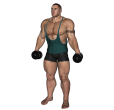 Dumbbell Curl - Alternate
Dumbbell Curl - Alternate
Benefits: This exercise works both heads of the biceps with a heavier weight than can typically be done with dumbbells.
Purpose: This exercise is used to target the biceps muscle to develop size, definition, strength, endurance and power.
Beginner Biceps Forearms Shoulders Strength Dumbbell Pull Gym
General Info: The biceps is a straight muscle with two heads. The long head of the biceps crosses both the elbow and the shoulder joint. It bends the elbow and raises the arm forward at the shoulder. The short head crosses the elbow joint and, in conjunction with the brachioradialis, supinates the hand.
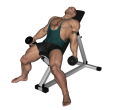 Dumbbell Curl - Alternate Incline
Dumbbell Curl - Alternate Incline
Benefits: The exercise eliminates cheating to isolate the biceps. The incline makes it more difficult to curl the dumbbells.
Purpose: This exercise works primarily the biceps with the front (anterior) shoulders and forearms acting as secondary muscles.
Beginner Biceps Forearms Anterior Shoulders Strength Dumbbell Incline Bench Pull Gym
General Info: The alternate incline dumbbell curl is an alternative exercise to the traditional seated or standing dumbbell curl. It is a favorite biceps builder among body builders.
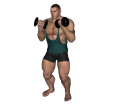 Dumbbell Curl - Basic
Dumbbell Curl - Basic
Benefits: This exercise works both heads of the biceps.
Purpose: This exercise is used to target the biceps muscle to develop size, definition, strength, endurance and power.
Beginner Biceps Forearms Shoulders Strength Dumbbell Pull Gym
General Info: The biceps is a straight muscle with two heads. The long head of the biceps crosses both the elbow and the shoulder joint. It bends the elbow and raises the arm forward at the shoulder. The short head crosses the elbow joint and, in conjunction with the brachioradialis, supinates the hand.
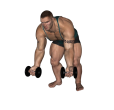 Dumbbell Curl - Bent Over
Dumbbell Curl - Bent Over
Benefits: This exercise is similar in effect to the Spider curl and does a good job of placing maximum tension on the biceps in the fully contracted position.
Purpose: This exercise works the biceps muscles but focuses also on the brachioradialis (a muscle that crosses the elbow joint and assists in rotating the forearm).
Beginner Biceps Forearms Shoulders Strength Dumbbell Pull Gym
General Info: The biceps is a straight muscle which has two heads. The long head crosses both the elbow and the shoulder joints. It bends the arm at the elbow and raises the arm forward at the shoulder. The short head crosses the elbow joint and, in conjunction with the brachioradialis, supinates the hand.
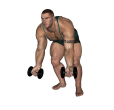 Dumbbell Curl - Bent Over Alternate
Dumbbell Curl - Bent Over Alternate
Benefits: This exercise works both heads of the biceps with a heavier weight than can typically be done with dumbbells.
Purpose: This exercise is used to target the biceps muscle to develop size, definition, strength, endurance and power.
Beginner Biceps Forearms Shoulders Strength Dumbbell Pull Gym
General Info: The biceps is a straight muscle with two heads. The long head of the biceps crosses both the elbow and the shoulder joint. It bends the elbow and raises the arm forward at the shoulder. The short head crosses the elbow joint and, in conjunction with the brachioradialis, supinates the hand.
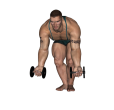 Dumbbell Curl - Bent Over Narrow
Dumbbell Curl - Bent Over Narrow
Benefits: This exercise is similar in effect to the Spider curl and does a good job of placing maximum tension on the biceps in the fully contracted position.
Purpose: This exercise works the biceps muscles but focuses also on the brachioradialis (a muscle that crosses the elbow joint and assists in rotating the forearm).
Beginner Biceps Forearms Shoulders Strength Dumbbell Pull Gym
General Info: The biceps is a straight muscle which has two heads. The long head crosses both the elbow and the shoulder joints. It bends the arm at the elbow and raises the arm forward at the shoulder. The short head crosses the elbow joint and, in conjunction with the brachioradialis, supinates the hand.
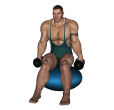 Dumbbell Curl - Fitness Ball
Dumbbell Curl - Fitness Ball
Benefits: This exercise isolates the biceps so that momentum does not come into play.
Purpose: This exercise strengthens the biceps.
Beginner Biceps Forearms Strength Dumbbell Fitness Ball Pull Gym
General Info: The biceps muscle is a straight muscle with 2 heads. The long head crosses both the elbow and shoulder joints and bends the elbow and raises the arm forward at the shoulder. The short head of the biceps crosses the elbow joint and, in conjunction with the brachioradialis, supinates the hand..
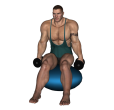 Dumbbell Curl - Fitness Ball Alternate
Dumbbell Curl - Fitness Ball Alternate
Benefits: This exercise isolates the biceps so that momentum does not come into play.
Purpose: This exercise strengthens the biceps.
Beginner Biceps Forearms Shoulders Traps Strength Dumbbell Fitness Ball Pull Gym
General Info: The biceps muscle is a straight muscle with 2 heads. The long head crosses both the elbow and shoulder joints and bends the elbow and raises the arm forward at the shoulder. The short head of the biceps crosses the elbow joint and, in conjunction with the brachioradialis, supinates the hand.
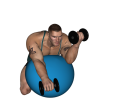 Dumbbell Curl - Fitness Ball Preacher Zottman Alternate
Dumbbell Curl - Fitness Ball Preacher Zottman Alternate
Benefits: This exercise isolates the biceps so that momentum does not come into play.
Purpose: This exercise strengthens the biceps.
Beginner Biceps Forearms Shoulders Traps Strength Dumbbell Fitness Ball Pull Gym
General Info: The biceps muscle is a straight muscle with 2 heads. The long head crosses both the elbow and shoulder joints and bends the elbow and raises the arm forward at the shoulder. The short head of the biceps crosses the elbow joint and, in conjunction with the brachioradialis, supinates the hand.
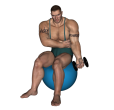 Dumbbell Curl - Fitness Ball Single
Dumbbell Curl - Fitness Ball Single
Benefits: This exercise isolates the biceps so that momentum does not come into play.
Purpose: This exercise strengthens the biceps.
Beginner Biceps Forearms Strength Dumbbell Fitness Ball Pull Gym
General Info: The biceps muscle is a straight muscle with 2 heads. The long head crosses both the elbow and shoulder joints and bends the elbow and raises the arm forward at the shoulder. The short head of the biceps crosses the elbow joint and, in conjunction with the brachioradialis, supinates the hand..
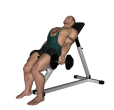 Dumbbell Curl - Flexor Incline
Dumbbell Curl - Flexor Incline
Benefits: The exercise eliminates cheating to isolate the biceps. The incline makes it more difficult to curl the dumbbells.
Purpose: This exercise works primarily the biceps with the front (anterior) shoulders and forearms acting as secondary muscles.
Beginner Biceps Forearms Anterior Shoulders Strength Dumbbell Incline Bench Pull Gym
General Info: The biceps muscle is a straight muscle with 2 heads. The long head crosses both the elbow and shoulder joints and bends the elbow and raises the arm forward at the shoulder. The short head of the biceps crosses the elbow joint and, in conjunction with the brachioradialis, supinates the hand.
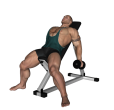 Dumbbell Curl - Incline
Dumbbell Curl - Incline
Benefits: The exercise eliminates cheating to isolate the biceps. The incline makes it more difficult to curl the dumbbells.
Purpose: This exercise works primarily the biceps with the front (anterior) shoulders and forearms acting as secondary muscles.
Beginner Biceps Forearms Anterior Shoulders Strength Dumbbell Incline Bench Pull Gym
General Info: The biceps muscle is a straight muscle with 2 heads. The long head crosses both the elbow and shoulder joints and bends the elbow and raises the arm forward at the shoulder. The short head of the biceps crosses the elbow joint and, in conjunction with the brachioradialis, supinates the hand.
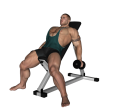 Dumbbell Curl - Incline Alternate
Dumbbell Curl - Incline Alternate
Benefits: The exercise eliminates cheating to isolate the biceps. The incline makes it more difficult to curl the dumbbells.
Purpose: This exercise works primarily the biceps with the front (anterior) shoulders and forearms acting as secondary muscles.
Beginner Biceps Forearms Anterior Shoulders Strength Dumbbell Incline Bench Pull Gym
General Info: The biceps muscle is a straight muscle with 2 heads. The long head crosses both the elbow and shoulder joints and bends the elbow and raises the arm forward at the shoulder. The short head of the biceps crosses the elbow joint and, in conjunction with the brachioradialis, supinates the hand.
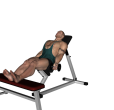 Dumbbell Curl - Incline Feet Up
Dumbbell Curl - Incline Feet Up
Benefits: The exercise eliminates cheating to isolate the biceps. The incline makes it more difficult to curl the dumbbells.
Purpose: This exercise works primarily the biceps with the front (anterior) shoulders and forearms acting as secondary muscles.
Beginner Biceps Forearms Anterior Shoulders Strength Dumbbell Incline Bench Pull Gym
General Info: The biceps muscle is a straight muscle with 2 heads. The long head crosses both the elbow and shoulder joints and bends the elbow and raises the arm forward at the shoulder. The short head of the biceps crosses the elbow joint and, in conjunction with the brachioradialis, supinates the hand.
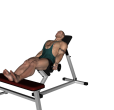 Dumbbell Curl - Incline Feet Up Alternate
Dumbbell Curl - Incline Feet Up Alternate
Benefits: The exercise eliminates cheating to isolate the biceps. The incline makes it more difficult to curl the dumbbells.
Purpose: This exercise works primarily the biceps with the front (anterior) shoulders and forearms acting as secondary muscles.
Beginner Biceps Forearms Anterior Shoulders Strength Dumbbell Incline Bench Pull Gym
General Info: The biceps muscle is a straight muscle with 2 heads. The long head crosses both the elbow and shoulder joints and bends the elbow and raises the arm forward at the shoulder. The short head of the biceps crosses the elbow joint and, in conjunction with the brachioradialis, supinates the hand.
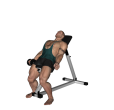 Dumbbell Curl - Incline Single
Dumbbell Curl - Incline Single
Benefits: This exercise works both heads of the biceps with a heavier weight than can typically be done with dumbbells.
Purpose: This exercise is used to target the biceps muscle to develop size, definition, strength, endurance and power.
Beginner Biceps Forearms Shoulders Strength Dumbbell Incline Bench Pull Gym
General Info: The biceps is a straight muscle with two heads. The long head of the biceps crosses both the elbow and the shoulder joint. It bends the elbow and raises the arm forward at the shoulder. The short head crosses the elbow joint and, in conjunction with the brachioradialis, supinates the hand.
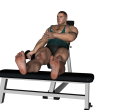 Dumbbell Curl - Incline Single Feet Up
Dumbbell Curl - Incline Single Feet Up
Benefits: This exercise works both heads of the biceps with a heavier weight than can typically be done with dumbbells.
Purpose: This exercise is used to target the biceps muscle to develop size, definition, strength, endurance and power.
Beginner Biceps Forearms Shoulders Strength Dumbbell Incline Bench Pull Gym
General Info: The biceps is a straight muscle with two heads. The long head of the biceps crosses both the elbow and the shoulder joint. It bends the elbow and raises the arm forward at the shoulder. The short head crosses the elbow joint and, in conjunction with the brachioradialis, supinates the hand.
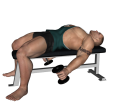 Dumbbell Curl - Lying Supine
Dumbbell Curl - Lying Supine
Benefits: This exercise isolates both heads of the biceps.
Purpose: This exercise is used to target the biceps muscle to develop size, definition, strength, endurance and power.
Beginner Biceps Forearms Strength Dumbbell Flat Bench Pull Gym
General Info: The biceps is a straight muscle with two heads. The long head of the biceps crosses both the elbow and the shoulder joint. It bends the elbow and raises the arm forward at the shoulder. The short head crosses the elbow joint and, in conjunction with the brachioradialis, supinates the hand.
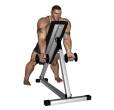 Dumbbell Curl - Overhang
Dumbbell Curl - Overhang
Benefits: This exercise is similar in effect to the Spider curl and does a good job of placing maximum tension on the biceps in the fully contracted position.
Purpose: This exercise works the biceps muscles.
Beginner Biceps Strength Dumbbell Incline Bench Pull Gym
General Info: The biceps muscle is a straight muscle with 2 heads. The long head crosses both the elbow and shoulder joints and bends the elbow and raises the arm forward at the shoulder. The short head of the biceps crosses the elbow joint and, in conjunction with the brachioradialis, supinates the hand.
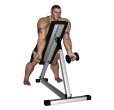 Dumbbell Curl - Overhang Alternate
Dumbbell Curl - Overhang Alternate
Benefits: This exercise is similar in effect to the Spider curl and does a good job of placing maximum tension on the biceps in the fully contracted position.
Purpose: This exercise works the biceps muscles.
Beginner Biceps Strength Dumbbell Incline Bench Pull Gym
General Info: The biceps muscle is a straight muscle with 2 heads. The long head crosses both the elbow and shoulder joints and bends the elbow and raises the arm forward at the shoulder. The short head of the biceps crosses the elbow joint and, in conjunction with the brachioradialis, supinates the hand.
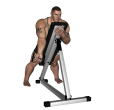 Dumbbell Curl - Overhang Single
Dumbbell Curl - Overhang Single
Benefits: This exercise is similar in effect to the Spider curl and does a good job of placing maximum tension on the biceps in the fully contracted position.
Purpose: This exercise works the biceps muscles.
Beginner Biceps Strength Dumbbell Incline Bench Pull Gym
General Info: The biceps muscle is a straight muscle with 2 heads. The long head crosses both the elbow and shoulder joints and bends the elbow and raises the arm forward at the shoulder. The short head of the biceps crosses the elbow joint and, in conjunction with the brachioradialis, supinates the hand.
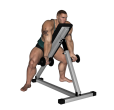 Dumbbell Curl - Prone Incline
Dumbbell Curl - Prone Incline
Benefits: This exercise works both heads of the biceps with a heavier weight than can typically be done with dumbbells.
Purpose: This exercise is used to target the biceps muscle to develop size, definition, strength, endurance and power.
Beginner Biceps Forearms Shoulders Strength Dumbbell Incline Bench Pull Gym
General Info: The biceps is a straight muscle with two heads. The long head of the biceps crosses both the elbow and the shoulder joint. It bends the elbow and raises the arm forward at the shoulder. The short head crosses the elbow joint and, in conjunction with the brachioradialis, supinates the hand.
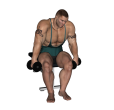 Dumbbell Curl - Seated
Dumbbell Curl - Seated
Benefits: This exercise isolates the biceps so that momentum does not come into play.
Purpose: This exercise strengthens the biceps.
Beginner Biceps Forearms Strength Dumbbell Flat Bench Pull Gym
General Info: The biceps muscle is a straight muscle with 2 heads. The long head crosses both the elbow and shoulder joints and bends the elbow and raises the arm forward at the shoulder. The short head of the biceps crosses the elbow joint and, in conjunction with the brachioradialis, supinates the hand..
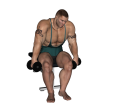 Dumbbell Curl - Seated Alternate
Dumbbell Curl - Seated Alternate
Benefits: This exercise isolates the biceps so that momentum does not come into play.
Purpose: This exercise strengthens the biceps.
Beginner Biceps Forearms Shoulders Traps Strength Dumbbell Flat Bench Pull Gym
General Info: The biceps muscle is a straight muscle with 2 heads. The long head crosses both the elbow and shoulder joints and bends the elbow and raises the arm forward at the shoulder. The short head of the biceps crosses the elbow joint and, in conjunction with the brachioradialis, supinates the hand..
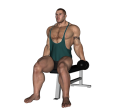 Dumbbell Curl - Seated Inner
Dumbbell Curl - Seated Inner
Benefits: This exercise isolates the biceps so that momentum does not come into play.
Purpose: This exercise strengthens the biceps.
Beginner Biceps Forearms Strength Dumbbell Flat Bench Pull Gym
General Info: The biceps muscle is a straight muscle with 2 heads. The long head crosses both the elbow and shoulder joints and bends the elbow and raises the arm forward at the shoulder. The short head of the biceps crosses the elbow joint and, in conjunction with the brachioradialis, supinates the hand..
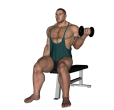 Dumbbell Curl - Seated Inner Alternate
Dumbbell Curl - Seated Inner Alternate
Benefits: This exercise isolates the biceps so that momentum does not come into play.
Purpose: This exercise strengthens the biceps.
Beginner Biceps Forearms Shoulders Traps Strength Dumbbell Flat Bench Pull Gym
General Info: The biceps muscle is a straight muscle with 2 heads. The long head crosses both the elbow and shoulder joints and bends the elbow and raises the arm forward at the shoulder. The short head of the biceps crosses the elbow joint and, in conjunction with the brachioradialis, supinates the hand..
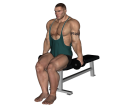 Dumbbell Curl - Seated Narrow Stance
Dumbbell Curl - Seated Narrow Stance
Benefits: This exercise isolates the biceps so that momentum does not come into play.
Purpose: This exercise strengthens the biceps.
Beginner Biceps Forearms Shoulders Traps Strength Dumbbell Flat Bench Pull Gym
General Info: The biceps muscle is a straight muscle with 2 heads. The long head crosses both the elbow and shoulder joints and bends the elbow and raises the arm forward at the shoulder. The short head of the biceps crosses the elbow joint and, in conjunction with the brachioradialis, supinates the hand..
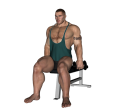 Dumbbell Curl - Seated Reverse
Dumbbell Curl - Seated Reverse
Benefits: This exercise isolates the biceps so that momentum does not come into play.
Purpose: This exercise strengthens the biceps.
Beginner Biceps Forearms Strength Dumbbell Flat Bench Pull Gym
General Info: The biceps muscle is a straight muscle with 2 heads. The long head crosses both the elbow and shoulder joints and bends the elbow and raises the arm forward at the shoulder. The short head of the biceps crosses the elbow joint and, in conjunction with the brachioradialis, supinates the hand..
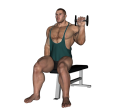 Dumbbell Curl - Seated Reverse Alternate
Dumbbell Curl - Seated Reverse Alternate
Benefits: This exercise isolates the biceps so that momentum does not come into play.
Purpose: This exercise strengthens the biceps.
Beginner Biceps Forearms Shoulders Traps Strength Dumbbell Flat Bench Pull Gym
General Info: The biceps muscle is a straight muscle with 2 heads. The long head crosses both the elbow and shoulder joints and bends the elbow and raises the arm forward at the shoulder. The short head of the biceps crosses the elbow joint and, in conjunction with the brachioradialis, supinates the hand..
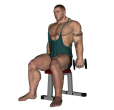 Dumbbell Curl - Seated Reverse Narrow Stance
Dumbbell Curl - Seated Reverse Narrow Stance
Benefits: This exercise isolates the biceps so that momentum does not come into play.
Purpose: This exercise strengthens the biceps.
Beginner Biceps Forearms Strength Dumbbell Flat Bench Pull Gym
General Info: The biceps muscle is a straight muscle with 2 heads. The long head crosses both the elbow and shoulder joints and bends the elbow and raises the arm forward at the shoulder. The short head of the biceps crosses the elbow joint and, in conjunction with the brachioradialis, supinates the hand..
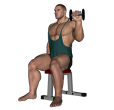 Dumbbell Curl - Seated Reverse Narrow Stance Alternate
Dumbbell Curl - Seated Reverse Narrow Stance Alternate
Benefits: This exercise isolates the biceps so that momentum does not come into play.
Purpose: This exercise strengthens the biceps.
Beginner Biceps Forearms Shoulders Traps Strength Dumbbell Flat Bench Pull Gym
General Info: The biceps muscle is a straight muscle with 2 heads. The long head crosses both the elbow and shoulder joints and bends the elbow and raises the arm forward at the shoulder. The short head of the biceps crosses the elbow joint and, in conjunction with the brachioradialis, supinates the hand..
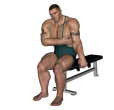 Dumbbell Curl - Seated Single
Dumbbell Curl - Seated Single
Benefits: This exercise isolates the biceps so that momentum does not come into play.
Purpose: This exercise strengthens the biceps.
Beginner Biceps Forearms Shoulders Traps Strength Dumbbell Flat Bench Pull Gym
General Info: The biceps muscle is a straight muscle with 2 heads. The long head crosses both the elbow and shoulder joints and bends the elbow and raises the arm forward at the shoulder. The short head of the biceps crosses the elbow joint and, in conjunction with the brachioradialis, supinates the hand..
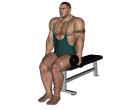 Dumbbell Curl - Seated Single Narrow
Dumbbell Curl - Seated Single Narrow
Benefits: This exercise isolates the biceps so that momentum does not come into play.
Purpose: This exercise strengthens the biceps.
Beginner Biceps Forearms Shoulders Traps Strength Dumbbell Flat Bench Pull Gym
General Info: The biceps muscle is a straight muscle with 2 heads. The long head crosses both the elbow and shoulder joints and bends the elbow and raises the arm forward at the shoulder. The short head of the biceps crosses the elbow joint and, in conjunction with the brachioradialis, supinates the hand..
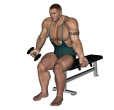 Dumbbell Curl - Seated Straight
Dumbbell Curl - Seated Straight
Benefits: This exercise isolates the biceps so that momentum does not come into play.
Purpose: This exercise strengthens the biceps.
Beginner Biceps Forearms Shoulders Traps Strength Dumbbell Flat Bench Pull Gym
General Info: The biceps muscle is a straight muscle with 2 heads. The long head crosses both the elbow and shoulder joints and bends the elbow and raises the arm forward at the shoulder. The short head of the biceps crosses the elbow joint and, in conjunction with the brachioradialis, supinates the hand..
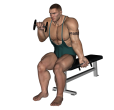 Dumbbell Curl - Seated Straight Alternate
Dumbbell Curl - Seated Straight Alternate
Benefits: This exercise isolates the biceps so that momentum does not come into play.
Purpose: This exercise strengthens the biceps.
Beginner Biceps Forearms Shoulders Traps Strength Dumbbell Flat Bench Pull Gym
General Info: The biceps muscle is a straight muscle with 2 heads. The long head crosses both the elbow and shoulder joints and bends the elbow and raises the arm forward at the shoulder. The short head of the biceps crosses the elbow joint and, in conjunction with the brachioradialis, supinates the hand.
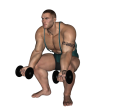 Dumbbell Curl - Squat
Dumbbell Curl - Squat
Benefits: This exercise isolates the biceps so that momentum does not come into play.
Purpose: This exercise strengthens the biceps.
Intermediate Biceps Forearms Shoulders Traps Strength Dumbbell Pull Gym
General Info: The biceps muscle is a straight muscle with 2 heads. The long head crosses both the elbow and shoulder joints and bends the elbow and raises the arm forward at the shoulder. The short head of the biceps crosses the elbow joint and, in conjunction with the brachioradialis, supinates the hand..
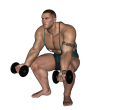 Dumbbell Curl - Squat Alternate
Dumbbell Curl - Squat Alternate
Benefits: This exercise isolates the biceps so that momentum does not come into play.
Purpose: This exercise strengthens the biceps.
Intermediate Biceps Forearms Shoulders Traps Strength Dumbbell Pull Gym
General Info: The biceps muscle is a straight muscle with 2 heads. The long head crosses both the elbow and shoulder joints and bends the elbow and raises the arm forward at the shoulder. The short head of the biceps crosses the elbow joint and, in conjunction with the brachioradialis, supinates the hand..
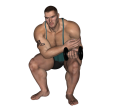 Dumbbell Curl - Squat Single
Dumbbell Curl - Squat Single
Benefits: This exercise isolates the biceps so that momentum does not come into play.
Purpose: This exercise strengthens the biceps.
Intermediate Biceps Forearms Shoulders Traps Strength Dumbbell Pull Gym
General Info: The biceps muscle is a straight muscle with 2 heads. The long head crosses both the elbow and shoulder joints and bends the elbow and raises the arm forward at the shoulder. The short head of the biceps crosses the elbow joint and, in conjunction with the brachioradialis, supinates the hand..
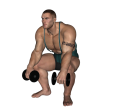 Dumbbell Curl - Squat Single Reverse
Dumbbell Curl - Squat Single Reverse
Benefits: This exercise isolates the biceps so that momentum does not come into play.
Purpose: This exercise strengthens the biceps.
Intermediate Biceps Forearms Shoulders Traps Strength Dumbbell Pull Gym
General Info: The biceps muscle is a straight muscle with 2 heads. The long head crosses both the elbow and shoulder joints and bends the elbow and raises the arm forward at the shoulder. The short head of the biceps crosses the elbow joint and, in conjunction with the brachioradialis, supinates the hand..
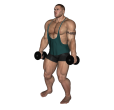 Dumbbell Curl - Standing
Dumbbell Curl - Standing
Benefits: This exercise works both heads of the biceps and isolates the biceps so that momentum does not come into play.
Purpose: This exercise is used to target the biceps muscle to develop size, definition, strength, endurance and power.
Beginner Biceps Forearms Shoulders Strength Dumbbell Pull Gym
General Info: The biceps is a straight muscle with two heads. The long head of the biceps crosses both the elbow and the shoulder joint. It bends the elbow and raises the arm forward at the shoulder. The short head crosses the elbow joint and, in conjunction with the brachioradialis, supinates the hand.
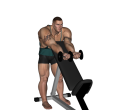 Dumbbell Curl - Standing Incline
Dumbbell Curl - Standing Incline
Benefits: This exercise works both heads of the biceps very similarly as the preacher curl.
Purpose: This exercise is used to target the biceps muscle to develop size, definition, strength, endurance and power.
Beginner Biceps Forearms Shoulders Strength Dumbbell Incline Bench Pull Gym
General Info: The biceps is a straight muscle with two heads. The long head of the biceps crosses both the elbow and the shoulder joint. It bends the elbow and raises the arm forward at the shoulder. The short head crosses the elbow joint and, in conjunction with the brachioradialis, supinates the hand.
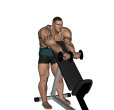 Dumbbell Curl - Standing Incline Alternate
Dumbbell Curl - Standing Incline Alternate
Benefits: This exercise works both heads of the biceps very similarly as the preacher curl.
Purpose: This exercise is used to target the biceps muscle to develop size, definition, strength, endurance and power.
Beginner Biceps Forearms Shoulders Strength Dumbbell Incline Bench Pull Gym
General Info: The biceps is a straight muscle with two heads. The long head of the biceps crosses both the elbow and the shoulder joint. It bends the elbow and raises the arm forward at the shoulder. The short head crosses the elbow joint and, in conjunction with the brachioradialis, supinates the hand.
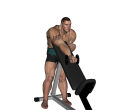 Dumbbell Curl - Standing Incline One Arm
Dumbbell Curl - Standing Incline One Arm
Benefits: This exercise works both heads of the biceps very similarly as the preacher curl.
Purpose: This exercise is used to target the biceps muscle to develop size, definition, strength, endurance and power.
Beginner Biceps Forearms Shoulders Strength Dumbbell Incline Bench Pull Gym
General Info: The biceps is a straight muscle with two heads. The long head of the biceps crosses both the elbow and the shoulder joint. It bends the elbow and raises the arm forward at the shoulder. The short head crosses the elbow joint and, in conjunction with the brachioradialis, supinates the hand.
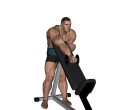 Dumbbell Curl - Standing Incline Single
Dumbbell Curl - Standing Incline Single
Benefits: This exercise works both heads of the biceps with a heavier weight than can typically be done with dumbbells.
Purpose: This exercise is used to target the biceps muscle to develop size, definition, strength, endurance and power.
Beginner Biceps Forearms Shoulders Strength Dumbbell Incline Bench Pull Gym
General Info: The biceps is a straight muscle with two heads. The long head of the biceps crosses both the elbow and the shoulder joint. It bends the elbow and raises the arm forward at the shoulder. The short head crosses the elbow joint and, in conjunction with the brachioradialis, supinates the hand.
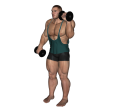 Dumbbell Curl - Standing Reverse Alternate
Dumbbell Curl - Standing Reverse Alternate
Benefits: This exercise works both heads of the biceps with a heavier weight than can typically be done with dumbbells.
Purpose: This exercise is used to target the biceps muscle to develop size, definition, strength, endurance and power.
Beginner Biceps Forearms Shoulders Strength Dumbbell Pull Gym
General Info: The biceps is a straight muscle with two heads. The long head of the biceps crosses both the elbow and the shoulder joint. It bends the elbow and raises the arm forward at the shoulder. The short head crosses the elbow joint and, in conjunction with the brachioradialis, supinates the hand.
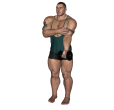 Dumbbell Curl - Standing Single
Dumbbell Curl - Standing Single
Benefits: This exercise works both heads of the biceps and isolates the biceps so that momentum does not come into play.
Purpose: This exercise is used to target the biceps muscle to develop size, definition, strength, endurance and power.
Beginner Biceps Forearms Shoulders Strength Dumbbell Pull Gym
General Info: The biceps is a straight muscle with two heads. The long head of the biceps crosses both the elbow and the shoulder joint. It bends the elbow and raises the arm forward at the shoulder. The short head crosses the elbow joint and, in conjunction with the brachioradialis, supinates the hand.
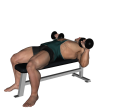 Dumbbell Press - Basic
Dumbbell Press - Basic
Benefits: Dumbbells do not limit your movement as much as a barbell does and thus makes greater demands on the stabilizing muscles.
Purpose: This exercise increases strength and strength speed, and produces greater functional strength for pressing movements.
Beginner Chest Triceps Strength Dumbbell Flat Bench Push Compound Gym
General Info: The chest is composed of the Pectoralis Major and the Pectoralis Minor. The Pec Major attaches to the upper arm and pulls the upper arm across the chest. The Pec Minor lies mostly underneath the Pec Major and draws the shoulder blade down and forward.
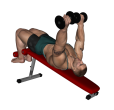 Dumbbell Press - Decline
Dumbbell Press - Decline
Benefits: This exercise works the chest muscles with a focus on your lower pecs.
Purpose: This exercise is used to target the lower pecs muscle to develop size, definition, strength, endurance and power.
Beginner Chest Triceps Shoulders Strength Dumbbell Decline Bench Push Compound Gym
General Info: The chest is composed of the Pectoralis Major and the Pectoralis Minor. The Pec Major attaches to the upper arm and pulls the upper arm across the chest. The Pec Minor lies mostly underneath the Pec Major and draws the shoulder blade down and forward.
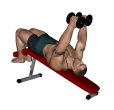 Dumbbell Press - Decline Inwards
Dumbbell Press - Decline Inwards
Benefits: Dumbbells do not limit your movement as much as a barbell does and thus makes greater demands on the stabilizing muscles.
Purpose: This exercise increases strength and strength speed, and produces greater functional strength for pressing movements.
Beginner Chest Triceps Strength Dumbbell Decline Bench Push Compound Gym
General Info: The chest is composed of the Pectoralis Major and the Pectoralis Minor. The Pec Major attaches to the upper arm and pulls the upper arm across the chest. The Pec Minor lies mostly underneath the Pec Major and draws the shoulder blade down and forward.
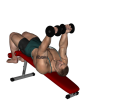 Dumbbell Press - Decline Reverse
Dumbbell Press - Decline Reverse
Benefits: This exercise works the chest muscles with a focus on your lower pecs. The reverse grip makes the exercise more difficult.
Purpose: This exercise is used to target the lower pecs muscle to develop size, definition, strength, endurance and power.
Beginner Chest Triceps Shoulders Strength Dumbbell Decline Bench Push Compound Gym
General Info: The chest is composed of the Pectoralis Major and the Pectoralis Minor. The Pec Major attaches to the upper arm and pulls the upper arm across the chest. The Pec Minor lies mostly underneath the Pec Major and draws the shoulder blade down and forward.
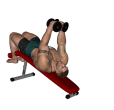 Dumbbell Press - Decline Reverse Rotation
Dumbbell Press - Decline Reverse Rotation
Benefits: This exercise works the chest muscles with a focus on your lower pecs. The reverse grip makes the exercise more difficult.
Purpose: This exercise is used to target the lower pecs muscle to develop size, definition, strength, endurance and power.
Beginner Chest Triceps Shoulders Strength Dumbbell Decline Bench Push Compound Gym
General Info: The chest is composed of the Pectoralis Major and the Pectoralis Minor. The Pec Major attaches to the upper arm and pulls the upper arm across the chest. The Pec Minor lies mostly underneath the Pec Major and draws the shoulder blade down and forward.
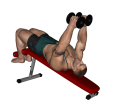 Dumbbell Press - Decline Rotation
Dumbbell Press - Decline Rotation
Benefits: Dumbbells do not limit your movement as much as a barbell does and thus makes greater demands on the stabilizing muscles.
Purpose: This exercise increases strength and strength speed, and produces greater functional strength for pressing movements.
Beginner Chest Triceps Strength Dumbbell Decline Bench Push Compound Gym
General Info: The chest is composed of the Pectoralis Major and the Pectoralis Minor. The Pec Major attaches to the upper arm and pulls the upper arm across the chest. The Pec Minor lies mostly underneath the Pec Major and draws the shoulder blade down and forward.
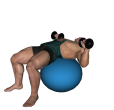 Dumbbell Press - Fitness Ball
Dumbbell Press - Fitness Ball
Benefits: Dumbbells do not limit your movement as much as a barbell does and thus makes greater demands on the stabilizing muscles.
Purpose: This exercise increases strength and strength speed, and produces greater functional strength for pressing movements.
Beginner Chest Triceps Strength Dumbbell Fitness Ball Push Compound Gym
General Info: The chest is composed of the Pectoralis Major and the Pectoralis Minor. The Pec Major attaches to the upper arm and pulls the upper arm across the chest. The Pec Minor lies mostly underneath the Pec Major and draws the shoulder blade down and forward.
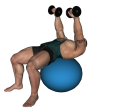 Dumbbell Press - Fitness Ball and Flye
Dumbbell Press - Fitness Ball and Flye
Benefits: A barbell allows someone to lift heavier weights and thus build more strength quicker. The flye part of the exercise works the anterior deltoids.
Purpose: This exercise increases strength and strength speed, and produces greater functional strength for pressing movements.
Intermediate Chest Triceps Anterior Delts Strength Dumbbell Fitness Ball Push Compound Gym
General Info: The chest is composed of the Pectoralis Major and the Pectoralis Minor. The Pec Major attaches to the upper arm and pulls the upper arm across the chest. The Pec Minor lies mostly underneath the Pec Major and draws the shoulder blade down and forward.
 Dumbbell Press - Fitness Ball and Flye Reverse
Dumbbell Press - Fitness Ball and Flye Reverse
Benefits: A barbell allows someone to lift heavier weights and thus build more strength quicker.
Purpose: This exercise increases strength and strength speed, and produces greater functional strength for pressing movements.
Intermediate Chest Triceps Anterior Delts Strength Dumbbell Fitness Ball Push Compound Gym
General Info: The chest is composed of the Pectoralis Major and the Pectoralis Minor. The Pec Major attaches to the upper arm and pulls the upper arm across the chest. The Pec Minor lies mostly underneath the Pec Major and draws the shoulder blade down and forward.
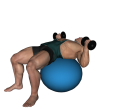 Dumbbell Press - Fitness Ball Reverse
Dumbbell Press - Fitness Ball Reverse
Benefits: Dumbbells do not limit your movement as much as a barbell does and thus makes greater demands on the stabilizing muscles. The reverse grip makes the exercise more difficult.
Purpose: This exercise increases strength and strength speed, and produces greater functional strength for pressing movements.
Beginner Chest Triceps Strength Dumbbell Fitness Ball Push Compound Gym
General Info: The chest is composed of the Pectoralis Major and the Pectoralis Minor. The Pec Major attaches to the upper arm and pulls the upper arm across the chest. The Pec Minor lies mostly underneath the Pec Major and draws the shoulder blade down and forward.
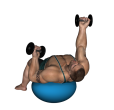 Dumbbell Press - Fitness Ball Reverse Alternate
Dumbbell Press - Fitness Ball Reverse Alternate
Benefits: Dumbbells do not limit your movement as much as a barbell does and thus makes greater demands on the stabilizing muscles.
Purpose: This exercise increases strength and strength speed, and produces greater functional strength for pressing movements.
Beginner Chest Triceps Strength Dumbbell Fitness Ball Push Compound Gym
General Info: The chest is composed of the Pectoralis Major and the Pectoralis Minor. The Pec Major attaches to the upper arm and pulls the upper arm across the chest. The Pec Minor lies mostly underneath the Pec Major and draws the shoulder blade down and forward.
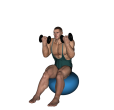 Dumbbell Press - Fitness Ball Rotation
Dumbbell Press - Fitness Ball Rotation
Benefits: Dumbbells do not limit your movement as much as a barbell does and thus makes greater demands on the stabilizing muscles.
Purpose: This exercise increases strength and strength speed, and produces greater functional strength for pressing movements.
Beginner Chest Triceps Strength Dumbbell Fitness Ball Push Compound Gym
General Info: The chest is composed of the Pectoralis Major and the Pectoralis Minor. The Pec Major attaches to the upper arm and pulls the upper arm across the chest. The Pec Minor lies mostly underneath the Pec Major and draws the shoulder blade down and forward.
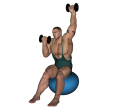 Dumbbell Press - Fitness Ball Rotation Alternate
Dumbbell Press - Fitness Ball Rotation Alternate
Benefits: Dumbbells do not limit your movement as much as a barbell does and thus makes greater demands on the stabilizing muscles.
Purpose: This exercise increases strength and strength speed, and produces greater functional strength for pressing movements.
Beginner Chest Triceps Strength Dumbbell Fitness Ball Push Compound Gym
General Info: The chest is composed of the Pectoralis Major and the Pectoralis Minor. The Pec Major attaches to the upper arm and pulls the upper arm across the chest. The Pec Minor lies mostly underneath the Pec Major and draws the shoulder blade down and forward.
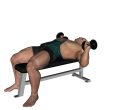 Dumbbell Press - Flat Bench
Dumbbell Press - Flat Bench
Benefits: Dumbbells do not limit your movement as much as a barbell does and thus makes greater demands on the stabilizing muscles.
Purpose: This exercise increases strength and strength speed, and produces greater functional strength for pressing movements.
Beginner Chest Triceps Strength Dumbbell Flat Bench Push Compound Gym
General Info: The chest is composed of the Pectoralis Major and the Pectoralis Minor. The Pec Major attaches to the upper arm and pulls the upper arm across the chest. The Pec Minor lies mostly underneath the Pec Major and draws the shoulder blade down and forward.
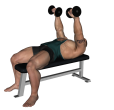 Dumbbell Press - Flat Bench and Flye
Dumbbell Press - Flat Bench and Flye
Benefits: Dumbbells do not limit your movement as much as a barbell does and thus makes greater demands on the stabilizing muscles. The flye part of the exercise works the anterior deltoids.
Purpose: This exercise increases strength and strength speed, and produces greater functional strength for pressing movements.
Intermediate Chest Triceps Anterior Delts Strength Dumbbell Flat Bench Push Compound Gym
General Info: The chest is composed of the Pectoralis Major and the Pectoralis Minor. The Pec Major attaches to the upper arm and pulls the upper arm across the chest. The Pec Minor lies mostly underneath the Pec Major and draws the shoulder blade down and forward.
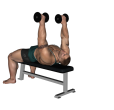 Dumbbell Press - Flat Bench and Flye Reverse
Dumbbell Press - Flat Bench and Flye Reverse
Benefits: A barbell allows someone to lift heavier weights and thus build more strength quicker.
Purpose: This exercise increases strength and strength speed, and produces greater functional strength for pressing movements.
Intermediate Chest Triceps Anterior Delts Strength Dumbbell Flat Bench Push Compound Gym
General Info: The chest is composed of the Pectoralis Major and the Pectoralis Minor. The Pec Major attaches to the upper arm and pulls the upper arm across the chest. The Pec Minor lies mostly underneath the Pec Major and draws the shoulder blade down and forward.
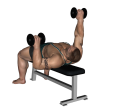 Dumbbell Press - Flat Bench Feet Up
Dumbbell Press - Flat Bench Feet Up
Benefits: Dumbbells do not limit your movement as much as a barbell does and thus makes greater demands on the stabilizing muscles.
Purpose: This exercise increases strength and strength speed, and produces greater functional strength for pressing movements.
Beginner Chest Triceps Strength Dumbbell Flat Bench Push Compound Gym
General Info: The chest is composed of the Pectoralis Major and the Pectoralis Minor. The Pec Major attaches to the upper arm and pulls the upper arm across the chest. The Pec Minor lies mostly underneath the Pec Major and draws the shoulder blade down and forward.
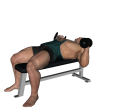 Dumbbell Press - Flat Bench Inwards
Dumbbell Press - Flat Bench Inwards
Benefits: Dumbbells do not limit your movement as much as a barbell does and thus makes greater demands on the stabilizing muscles.
Purpose: This exercise increases strength and strength speed, and produces greater functional strength for pressing movements.
Beginner Chest Triceps Strength Dumbbell Flat Bench Push Compound Gym
General Info: The chest is composed of the Pectoralis Major and the Pectoralis Minor. The Pec Major attaches to the upper arm and pulls the upper arm across the chest. The Pec Minor lies mostly underneath the Pec Major and draws the shoulder blade down and forward.
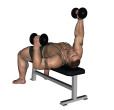 Dumbbell Press - Flat Bench Inwards Alternate
Dumbbell Press - Flat Bench Inwards Alternate
Benefits: Dumbbells do not limit your movement as much as a barbell does and thus makes greater demands on the stabilizing muscles.
Purpose: This exercise increases strength and strength speed, and produces greater functional strength for pressing movements.
Beginner Chest Triceps Strength Dumbbell Flat Bench Push Compound Gym
General Info: The chest is composed of the Pectoralis Major and the Pectoralis Minor. The Pec Major attaches to the upper arm and pulls the upper arm across the chest. The Pec Minor lies mostly underneath the Pec Major and draws the shoulder blade down and forward.
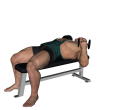 Dumbbell Press - Flat Bench Reverse
Dumbbell Press - Flat Bench Reverse
Benefits: Dumbbells do not limit your movement as much as a barbell does and thus makes greater demands on the stabilizing muscles. The reverse grip makes the exercise more difficult.
Purpose: This exercise increases strength and strength speed, and produces greater functional strength for pressing movements.
Beginner Chest Triceps Strength Dumbbell Flat Bench Push Compound Gym
General Info: The chest is composed of the Pectoralis Major and the Pectoralis Minor. The Pec Major attaches to the upper arm and pulls the upper arm across the chest. The Pec Minor lies mostly underneath the Pec Major and draws the shoulder blade down and forward.
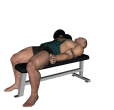 Dumbbell Press - Flat Bench Single
Dumbbell Press - Flat Bench Single
Benefits: Dumbbells do not limit your movement as much as a barbell does and thus makes greater demands on the stabilizing muscles.
Purpose: This exercise increases strength and strength speed, and produces greater functional strength for pressing movements.
Beginner Chest Triceps Strength Dumbbell Flat Bench Push Compound Gym
General Info: The chest is composed of the Pectoralis Major and the Pectoralis Minor. The Pec Major attaches to the upper arm and pulls the upper arm across the chest. The Pec Minor lies mostly underneath the Pec Major and draws the shoulder blade down and forward.
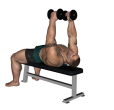 Dumbbell Press - Flat Reverse and Flye
Dumbbell Press - Flat Reverse and Flye
Benefits: A barbell allows someone to lift heavier weights and thus build more strength quicker.
Purpose: This exercise increases strength and strength speed, and produces greater functional strength for pressing movements.
Intermediate Chest Triceps Anterior Delts Strength Dumbbell Flat Bench Push Compound Gym
General Info: The chest is composed of the Pectoralis Major and the Pectoralis Minor. The Pec Major attaches to the upper arm and pulls the upper arm across the chest. The Pec Minor lies mostly underneath the Pec Major and draws the shoulder blade down and forward.
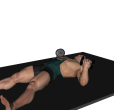 Dumbbell Press - Floor
Dumbbell Press - Floor
Benefits: Dumbbells do not limit your movement as much as a barbell does and thus makes greater demands on the stabilizing muscles.
Purpose: This exercise increases strength and strength speed, and produces greater functional strength for pressing movements.
Beginner Chest Triceps Strength Dumbbell Push Compound Gym
General Info: The chest is composed of the Pectoralis Major and the Pectoralis Minor. The Pec Major attaches to the upper arm and pulls the upper arm across the chest. The Pec Minor lies mostly underneath the Pec Major and draws the shoulder blade down and forward.
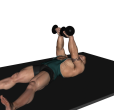 Dumbbell Press - Floor and Flye
Dumbbell Press - Floor and Flye
Benefits: Dumbbells do not limit your movement as much as a barbell does and thus makes greater demands on the stabilizing muscles. The flye part of the exercise works the anterior deltoids.
Purpose: This exercise increases strength and strength speed, and produces greater functional strength for pressing movements.
Intermediate Chest Triceps Anterior Delts Strength Dumbbell Push Compound Gym
General Info: The chest is composed of the Pectoralis Major and the Pectoralis Minor. The Pec Major attaches to the upper arm and pulls the upper arm across the chest. The Pec Minor lies mostly underneath the Pec Major and draws the shoulder blade down and forward.
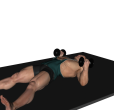 Dumbbell Press - Floor Inwards
Dumbbell Press - Floor Inwards
Benefits: Dumbbells do not limit your movement as much as a barbell does and thus makes greater demands on the stabilizing muscles.
Purpose: This exercise increases strength and strength speed, and produces greater functional strength for pressing movements.
Beginner Chest Triceps Strength Dumbbell Push Compound Gym
General Info: The chest is composed of the Pectoralis Major and the Pectoralis Minor. The Pec Major attaches to the upper arm and pulls the upper arm across the chest. The Pec Minor lies mostly underneath the Pec Major and draws the shoulder blade down and forward.
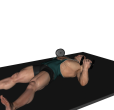 Dumbbell Press - Floor Reverse
Dumbbell Press - Floor Reverse
Benefits: Dumbbells do not limit your movement as much as a barbell does and thus makes greater demands on the stabilizing muscles. The reverse grip makes the exercise more difficult.
Purpose: This exercise increases strength and strength speed, and produces greater functional strength for pressing movements.
Beginner Chest Triceps Strength Dumbbell Push Compound Gym
General Info: The chest is composed of the Pectoralis Major and the Pectoralis Minor. The Pec Major attaches to the upper arm and pulls the upper arm across the chest. The Pec Minor lies mostly underneath the Pec Major and draws the shoulder blade down and forward.
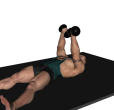 Dumbbell Press - Floor Reverse and Flye
Dumbbell Press - Floor Reverse and Flye
Benefits: Dumbbells do not limit your movement as much as a barbell does and thus makes greater demands on the stabilizing muscles. The reverse grip makes the exercise more difficult. The flye part of the exercise works the anterior deltoids.
Purpose: This exercise increases strength and strength speed, and produces greater functional strength for pressing movements.
Intermediate Chest Triceps Anterior Delts Strength Dumbbell Push Compound Gym
General Info: The chest is composed of the Pectoralis Major and the Pectoralis Minor. The Pec Major attaches to the upper arm and pulls the upper arm across the chest. The Pec Minor lies mostly underneath the Pec Major and draws the shoulder blade down and forward.
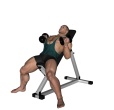 Dumbbell Press - Hammer Incline
Dumbbell Press - Hammer Incline
Benefits: A Hammer Grip isolates the chest muscles.
Purpose: This exercise increases strength and size.
Beginner Chest Triceps Strength Dumbbell Incline Bench Push Compound Gym
General Info: The chest is composed of the Pectoralis Major and the Pectoralis Minor. The Pec Major attaches to the upper arm and pulls the upper arm across the chest. The Pec Minor lies mostly underneath the Pec Major and draws the shoulder blade down and forward.
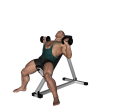 Dumbbell Press - Incline
Dumbbell Press - Incline
Benefits: This exercise works the chest muscles with a focus on your upper pecs.
Purpose: This exercise is used to target the upper pecs muscle to develop size, definition, strength, endurance and power.
Beginner Chest Triceps Shoulders Strength Dumbbell Incline Bench Push Compound Gym
General Info: The chest is composed of the Pectoralis Major and the Pectoralis Minor. The Pec Major attaches to the upper arm and pulls the upper arm across the chest. The Pec Minor lies mostly underneath the Pec Major and draws the shoulder blade down and forward.
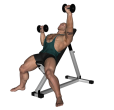 Dumbbell Press - Incline Alternate
Dumbbell Press - Incline Alternate
Benefits: This exercise works the chest muscles with a focus on your upper pecs.
Purpose: This exercise is used to target the upper pecs muscle to develop size, definition, strength, endurance and power.
Beginner Chest Triceps Shoulders Strength Dumbbell Incline Bench Push Compound Gym
General Info: The chest is composed of the Pectoralis Major and the Pectoralis Minor. The Pec Major attaches to the upper arm and pulls the upper arm across the chest. The Pec Minor lies mostly underneath the Pec Major and draws the shoulder blade down and forward.
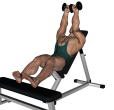 Dumbbell Press - Incline Feet Up
Dumbbell Press - Incline Feet Up
Benefits: This exercise works the chest muscles with a focus on your upper pecs.
Purpose: This exercise is used to target the upper pecs muscle to develop size, definition, strength, endurance and power.
Beginner Chest Triceps Shoulders Strength Dumbbell Incline Bench Push Compound Gym
General Info: The chest is composed of the Pectoralis Major and the Pectoralis Minor. The Pec Major attaches to the upper arm and pulls the upper arm across the chest. The Pec Minor lies mostly underneath the Pec Major and draws the shoulder blade down and forward.
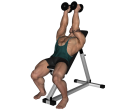 Dumbbell Press - Incline Inwards
Dumbbell Press - Incline Inwards
Benefits: This exercise works the chest muscles with a focus on your upper pecs.
Purpose: This exercise is used to target the upper pecs muscle to develop size, definition, strength, endurance and power.
Beginner Chest Triceps Shoulders Strength Dumbbell Incline Bench Push Compound Gym
General Info: The chest is composed of the Pectoralis Major and the Pectoralis Minor. The Pec Major attaches to the upper arm and pulls the upper arm across the chest. The Pec Minor lies mostly underneath the Pec Major and draws the shoulder blade down and forward.
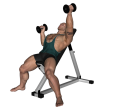 Dumbbell Press - Incline Inwards Alternate
Dumbbell Press - Incline Inwards Alternate
Benefits: This exercise works the chest muscles with a focus on your upper pecs.
Purpose: This exercise is used to target the upper pecs muscle to develop size, definition, strength, endurance and power.
Beginner Chest Triceps Shoulders Strength Dumbbell Incline Bench Push Compound Gym
General Info: The chest is composed of the Pectoralis Major and the Pectoralis Minor. The Pec Major attaches to the upper arm and pulls the upper arm across the chest. The Pec Minor lies mostly underneath the Pec Major and draws the shoulder blade down and forward.
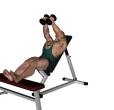 Dumbbell Press - Incline Inwards Feet Up
Dumbbell Press - Incline Inwards Feet Up
Benefits: This exercise works the chest muscles with a focus on your upper pecs.
Purpose: This exercise is used to target the upper pecs muscle to develop size, definition, strength, endurance and power.
Beginner Chest Triceps Shoulders Strength Dumbbell Incline Bench Push Compound Gym
General Info: The chest is composed of the Pectoralis Major and the Pectoralis Minor. The Pec Major attaches to the upper arm and pulls the upper arm across the chest. The Pec Minor lies mostly underneath the Pec Major and draws the shoulder blade down and forward.
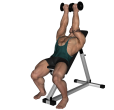 Dumbbell Press - Incline Reverse
Dumbbell Press - Incline Reverse
Benefits: This exercise works the chest muscles with a focus on your upper pecs.
Purpose: This exercise is used to target the upper pecs muscle to develop size, definition, strength, endurance and power.
Beginner Chest Triceps Shoulders Strength Dumbbell Incline Bench Push Compound Gym
General Info: The chest is composed of the Pectoralis Major and the Pectoralis Minor. The Pec Major attaches to the upper arm and pulls the upper arm across the chest. The Pec Minor lies mostly underneath the Pec Major and draws the shoulder blade down and forward.
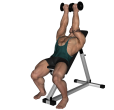 Dumbbell Press - Incline Reverse Alternate
Dumbbell Press - Incline Reverse Alternate
Benefits: This exercise works the chest muscles with a focus on your upper pecs.
Purpose: This exercise is used to target the upper pecs muscle to develop size, definition, strength, endurance and power.
Beginner Chest Triceps Shoulders Strength Dumbbell Incline Bench Push Compound Gym
General Info: The chest is composed of the Pectoralis Major and the Pectoralis Minor. The Pec Major attaches to the upper arm and pulls the upper arm across the chest. The Pec Minor lies mostly underneath the Pec Major and draws the shoulder blade down and forward.
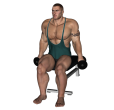 Dumbbell Pull - Seated Bent Over
Dumbbell Pull - Seated Bent Over
Benefits: This exercise has a different resistance curve from back extensions so these two exercises make a good combination.
Purpose: This exercise can be a powerful tool for developing the spinal erectors.
Intermediate Lower Back Hamstrings Glutes Strength Dumbbell Flat Bench Push Compound Gym
General Info: The muscles of the lower back straighten the spine. They work together with the abdominals to keep the spine upright. Good Mornings places a lot of stress on the lower back.
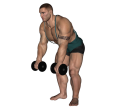 Dumbbell Row - Basic
Dumbbell Row - Basic
Benefits: This exercise is a strong, effective free weight back exercise for building muscle mass and size of the lats.
Purpose: This is a good exercise for increasing strength and size in the upper back.
Intermediate Traps Lats Triceps Posterior Delts Strength Dumbbell Pull Compound Gym
General Info: There are a number of muscles in the back, although the two major muscles are the lats and traps. The lats pulls the arm back and down towards the spine. The traps pull the shoulder blades back and towards the spine.
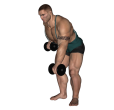 Dumbbell Row - Basic Alternate
Dumbbell Row - Basic Alternate
Benefits: This exercise is a strong, effective free weight back exercise for building muscle mass and size of the lats.
Purpose: This is a good exercise for increasing strength and size in the upper back.
Intermediate Traps Lats Triceps Posterior Delts Strength Dumbbell Pull Compound Gym
General Info: There are a number of muscles in the back, although the two major muscles are the lats and traps. The lats pulls the arm back and down towards the spine. The traps pull the shoulder blades back and towards the spine.
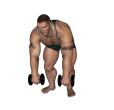 Dumbbell Row - Bent Over
Dumbbell Row - Bent Over
Benefits: This exercise is a strong, effective free weight back exercise for building muscle mass and size of the lats.
Purpose: This is a good exercise for increasing strength and size in the upper back.
Intermediate Traps Lats Triceps Posterior Delts Strength Dumbbell Pull Compound Gym
General Info: There are a number of muscles in the back, although the two major muscles are the lats and traps. The lats pulls the arm back and down towards the spine. The traps pull the shoulder blades back and towards the spine.
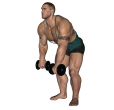 Dumbbell Row - Bent Over Alternate
Dumbbell Row - Bent Over Alternate
Benefits: This exercise is a strong, effective free weight back exercise for building muscle mass and size of the lats.
Purpose: This is a good exercise for increasing strength and size in the upper back.
Intermediate Traps Lats Triceps Posterior Delts Strength Dumbbell Pull Compound Gym
General Info: There are a number of muscles in the back, although the two major muscles are the lats and traps. The lats pulls the arm back and down towards the spine. The traps pull the shoulder blades back and towards the spine.
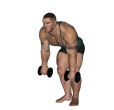 Dumbbell Row - Bent Over Close Stance Alternate
Dumbbell Row - Bent Over Close Stance Alternate
Benefits: This exercise is a strong, effective free weight back exercise for building muscle mass and size of the lats.
Purpose: This is a good exercise for increasing strength and size in the upper back.
Intermediate Traps Lats Triceps Posterior Delts Strength Dumbbell Pull Compound Gym
General Info: There are a number of muscles in the back, although the two major muscles are the lats and traps. The lats pulls the arm back and down towards the spine. The traps pull the shoulder blades back and towards the spine.
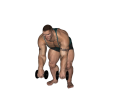 Dumbbell Row - Bent Over Dual
Dumbbell Row - Bent Over Dual
Benefits: This exercise is a strong, effective free weight back exercise for building muscle mass and size of the lats.
Purpose: This is a good exercise for increasing strength and size in the upper back.
Intermediate Traps Lats Triceps Posterior Delts Strength Dumbbell Pull Compound Gym
General Info: There are a number of muscles in the back, although the two major muscles are the lats and traps. The lats pulls the arm back and down towards the spine. The traps pull the shoulder blades back and towards the spine.
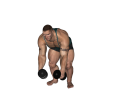 Dumbbell Row - Bent Over Dual Palms In
Dumbbell Row - Bent Over Dual Palms In
Benefits: This exercise is a strong, effective free weight back exercise for building muscle mass and size of the lats.
Purpose: This is a good exercise for increasing strength and size in the upper back.
Intermediate Traps Lats Triceps Posterior Delts Strength Dumbbell Pull Compound Gym
General Info: There are a number of muscles in the back, although the two major muscles are the lats and traps. The lats pulls the arm back and down towards the spine. The traps pull the shoulder blades back and towards the spine.
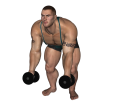 Dumbbell Row - Bent Over Inwards
Dumbbell Row - Bent Over Inwards
Benefits: This exercise is a strong, effective free weight back exercise for building muscle mass and size of the lats.
Purpose: This is a good exercise for increasing strength and size in the upper back.
Intermediate Traps Lats Triceps Posterior Delts Strength Dumbbell Pull Compound Gym
General Info: There are a number of muscles in the back, although the two major muscles are the lats and traps. The lats pulls the arm back and down towards the spine. The traps pull the shoulder blades back and towards the spine.
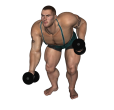 Dumbbell Row - Bent Over Inwards Alternate
Dumbbell Row - Bent Over Inwards Alternate
Benefits: This exercise is a strong, effective free weight back exercise for building muscle mass and size of the lats.
Purpose: This is a good exercise for increasing strength and size in the upper back.
Intermediate Traps Lats Triceps Posterior Delts Strength Dumbbell Pull Compound Gym
General Info: There are a number of muscles in the back, although the two major muscles are the lats and traps. The lats pulls the arm back and down towards the spine. The traps pull the shoulder blades back and towards the spine.
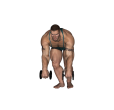 Dumbbell Row - Bent Over Narrow Stance
Dumbbell Row - Bent Over Narrow Stance
Benefits: This exercise is a strong, effective free weight back exercise for building muscle mass and size of the lats.
Purpose: This is a good exercise for increasing strength and size in the upper back.
Intermediate Traps Lats Triceps Posterior Delts Strength Dumbbell Pull Compound Gym
General Info: There are a number of muscles in the back, although the two major muscles are the lats and traps. The lats pulls the arm back and down towards the spine. The traps pull the shoulder blades back and towards the spine.
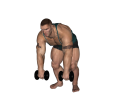 Dumbbell Row - Bent Over Rotation
Dumbbell Row - Bent Over Rotation
Benefits: This exercise is a strong, effective free weight back exercise for building muscle mass and size of the lats.
Purpose: This is a good exercise for increasing strength and size in the upper back.
Intermediate Traps Lats Triceps Posterior Delts Strength Dumbbell Pull Compound Gym
General Info: There are a number of muscles in the back, although the two major muscles are the lats and traps. The lats pulls the arm back and down towards the spine. The traps pull the shoulder blades back and towards the spine.
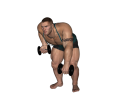 Dumbbell Row - Bent Over Rotation Alternate
Dumbbell Row - Bent Over Rotation Alternate
Benefits: This exercise is a strong, effective free weight back exercise for building muscle mass and size of the lats.
Purpose: This is a good exercise for increasing strength and size in the upper back.
Intermediate Traps Lats Triceps Posterior Delts Strength Dumbbell Pull Compound Gym
General Info: There are a number of muscles in the back, although the two major muscles are the lats and traps. The lats pulls the arm back and down towards the spine. The traps pull the shoulder blades back and towards the spine.
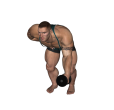 Dumbbell Row - Bent Over Single Inwards
Dumbbell Row - Bent Over Single Inwards
Benefits: This exercise is a strong, effective free weight back exercise for building muscle mass and size of the lats.
Purpose: This is a good exercise for increasing strength and size in the upper back.
Intermediate Traps Lats Triceps Posterior Delts Strength Dumbbell Pull Compound Gym
General Info: There are a number of muscles in the back, although the two major muscles are the lats and traps. The lats pulls the arm back and down towards the spine. The traps pull the shoulder blades back and towards the spine.
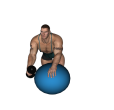 Dumbbell Row - Fitness Ball Inwards
Dumbbell Row - Fitness Ball Inwards
Benefits: This exercise is a strong, effective free weight back exercise for building muscle mass and size of the lats.
Purpose: This is a good exercise for increasing strength and size in the upper back.
Intermediate Traps Lats Triceps Posterior Delts Strength Dumbbell Fitness Ball Pull Compound Gym
General Info: There are a number of muscles in the back, although the two major muscles are the lats and traps. The lats pulls the arm back and down towards the spine. The traps pull the shoulder blades back and towards the spine.
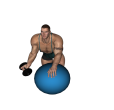 Dumbbell Row - Fitness Ball Rotation Version 1
Dumbbell Row - Fitness Ball Rotation Version 1
Benefits: This exercise is a strong, effective free weight back exercise for building muscle mass and size of the lats.
Purpose: This is a good exercise for increasing strength and size in the upper back.
Intermediate Traps Lats Triceps Posterior Delts Strength Dumbbell Fitness Ball Pull Compound Gym
General Info: There are a number of muscles in the back, although the two major muscles are the lats and traps. The lats pulls the arm back and down towards the spine. The traps pull the shoulder blades back and towards the spine.
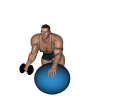 Dumbbell Row - Fitness Ball Rotation Version 2
Dumbbell Row - Fitness Ball Rotation Version 2
Benefits: This exercise is a strong, effective free weight back exercise for building muscle mass and size of the lats.
Purpose: This is a good exercise for increasing strength and size in the upper back.
Intermediate Traps Lats Triceps Posterior Delts Strength Dumbbell Fitness Ball Pull Compound Gym
General Info: There are a number of muscles in the back, although the two major muscles are the lats and traps. The lats pulls the arm back and down towards the spine. The traps pull the shoulder blades back and towards the spine.
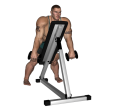 Dumbbell Row - Incline
Dumbbell Row - Incline
Benefits: This exercise is a strong, effective free weight back exercise for building muscle mass and size of the lats.
Purpose: This is a good exercise for increasing strength and size in the upper back.
Intermediate Traps Lats Triceps Posterior Delts Strength Dumbbell Incline Bench Pull Compound Gym
General Info: There are a number of muscles in the back, although the two major muscles are the lats and traps. The lats pulls the arm back and down towards the spine. The traps pull the shoulder blades back and towards the spine.
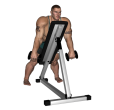 Dumbbell Row - Incline Alternate
Dumbbell Row - Incline Alternate
Benefits: This exercise is a strong, effective free weight back exercise for building muscle mass and size of the lats.
Purpose: This is a good exercise for increasing strength and size in the upper back.
Intermediate Traps Lats Triceps Posterior Delts Strength Dumbbell Incline Bench Pull Compound Gym
General Info: There are a number of muscles in the back, although the two major muscles are the lats and traps. The lats pulls the arm back and down towards the spine. The traps pull the shoulder blades back and towards the spine.
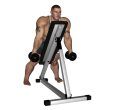 Dumbbell Row - Incline Inwards
Dumbbell Row - Incline Inwards
Benefits: This exercise is a strong, effective free weight back exercise for building muscle mass and size of the lats.
Purpose: This is a good exercise for increasing strength and size in the upper back.
Intermediate Traps Lats Triceps Posterior Delts Strength Dumbbell Incline Bench Pull Compound Gym
General Info: There are a number of muscles in the back, although the two major muscles are the lats and traps. The lats pulls the arm back and down towards the spine. The traps pull the shoulder blades back and towards the spine.
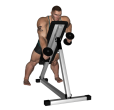 Dumbbell Row - Incline Inwards Alternate
Dumbbell Row - Incline Inwards Alternate
Benefits: This exercise is a strong, effective free weight back exercise for building muscle mass and size of the lats.
Purpose: This is a good exercise for increasing strength and size in the upper back.
Intermediate Traps Lats Triceps Posterior Delts Strength Dumbbell Incline Bench Pull Compound Gym
General Info: There are a number of muscles in the back, although the two major muscles are the lats and traps. The lats pulls the arm back and down towards the spine. The traps pull the shoulder blades back and towards the spine.
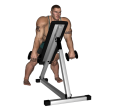 Dumbbell Row - Incline Rotation
Dumbbell Row - Incline Rotation
Benefits: This exercise is a strong, effective free weight back exercise for building muscle mass and size of the lats.
Purpose: This is a good exercise for increasing strength and size in the upper back.
Intermediate Traps Lats Triceps Posterior Delts Strength Dumbbell Incline Bench Pull Compound Gym
General Info: There are a number of muscles in the back, although the two major muscles are the lats and traps. The lats pulls the arm back and down towards the spine. The traps pull the shoulder blades back and towards the spine.
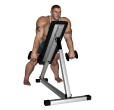 Dumbbell Row - Incline Rotation Alternate
Dumbbell Row - Incline Rotation Alternate
Benefits: This exercise is a strong, effective free weight back exercise for building muscle mass and size of the lats.
Purpose: This is a good exercise for increasing strength and size in the upper back.
Intermediate Traps Lats Triceps Posterior Delts Strength Dumbbell Incline Bench Pull Compound Gym
General Info: There are a number of muscles in the back, although the two major muscles are the lats and traps. The lats pulls the arm back and down towards the spine. The traps pull the shoulder blades back and towards the spine.
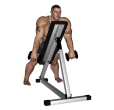 Dumbbell Row - Incline Single
Dumbbell Row - Incline Single
Benefits: This exercise is a strong, effective free weight back exercise for building muscle mass and size of the lats.
Purpose: This is a good exercise for increasing strength and size in the upper back.
Intermediate Traps Lats Triceps Posterior Delts Strength Dumbbell Incline Bench Pull Compound Gym
General Info: There are a number of muscles in the back, although the two major muscles are the lats and traps. The lats pulls the arm back and down towards the spine. The traps pull the shoulder blades back and towards the spine.
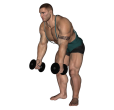 Dumbbell Row - Inwards
Dumbbell Row - Inwards
Benefits: This exercise is a strong, effective free weight back exercise for building muscle mass and size of the lats.
Purpose: This is a good exercise for increasing strength and size in the upper back.
Intermediate Traps Lats Triceps Posterior Delts Strength Dumbbell Pull Compound Gym
General Info: There are a number of muscles in the back, although the two major muscles are the lats and traps. The lats pulls the arm back and down towards the spine. The traps pull the shoulder blades back and towards the spine.
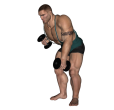 Dumbbell Row - Inwards Alternate
Dumbbell Row - Inwards Alternate
Benefits: This exercise is a strong, effective free weight back exercise for building muscle mass and size of the lats.
Purpose: This is a good exercise for increasing strength and size in the upper back.
Intermediate Traps Lats Triceps Posterior Delts Strength Dumbbell Pull Compound Gym
General Info: There are a number of muscles in the back, although the two major muscles are the lats and traps. The lats pulls the arm back and down towards the spine. The traps pull the shoulder blades back and towards the spine.
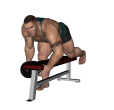 Dumbbell Row - One Arm
Dumbbell Row - One Arm
Benefits: This exercise is a strong, effective free weight back exercise for building muscle mass and size of the lats.
Purpose: This is a good exercise for increasing strength and size in the upper back.
Intermediate Traps Lats Triceps Posterior Delts Strength Dumbbell Pull Compound Gym
General Info: There are a number of muscles in the back, although the two major muscles are the lats and traps. The lats pulls the arm back and down towards the spine. The traps pull the shoulder blades back and towards the spine.
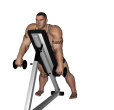 Dumbbell Row - Overhang
Dumbbell Row - Overhang
Benefits: This exercise is a strong, effective free weight back exercise for building muscle mass and size of the lats.
Purpose: This is a good exercise for increasing strength and size in the upper back.
Intermediate Traps Lats Triceps Posterior Delts Strength Dumbbell Incline Bench Pull Compound Gym
General Info: There are a number of muscles in the back, although the two major muscles are the lats and traps. The lats pulls the arm back and down towards the spine. The traps pull the shoulder blades back and towards the spine.
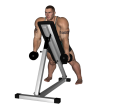 Dumbbell Row - Overhang Inwards
Dumbbell Row - Overhang Inwards
Benefits: This exercise is a strong, effective free weight back exercise for building muscle mass and size of the lats.
Purpose: This is a good exercise for increasing strength and size in the upper back.
Intermediate Traps Lats Triceps Posterior Delts Strength Dumbbell Incline Bench Pull Compound Gym
General Info: There are a number of muscles in the back, although the two major muscles are the lats and traps. The lats pulls the arm back and down towards the spine. The traps pull the shoulder blades back and towards the spine.
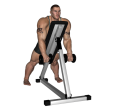 Dumbbell Row - Overhang Single
Dumbbell Row - Overhang Single
Benefits: This exercise is a strong, effective free weight back exercise for building muscle mass and size of the lats.
Purpose: This is a good exercise for increasing strength and size in the upper back.
Intermediate Traps Lats Triceps Posterior Delts Strength Dumbbell Incline Bench Pull Compound Gym
General Info: There are a number of muscles in the back, although the two major muscles are the lats and traps. The lats pulls the arm back and down towards the spine. The traps pull the shoulder blades back and towards the spine.
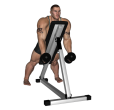 Dumbbell Row - Overhang Single Inwards
Dumbbell Row - Overhang Single Inwards
Benefits: This exercise is a strong, effective free weight back exercise for building muscle mass and size of the lats.
Purpose: This is a good exercise for increasing strength and size in the upper back.
Intermediate Traps Lats Triceps Posterior Delts Strength Dumbbell Incline Bench Pull Compound Gym
General Info: There are a number of muscles in the back, although the two major muscles are the lats and traps. The lats pulls the arm back and down towards the spine. The traps pull the shoulder blades back and towards the spine.
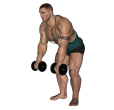 Dumbbell Row - Rotation
Dumbbell Row - Rotation
Benefits: This exercise is a strong, effective free weight back exercise for building muscle mass and size of the lats.
Purpose: This is a good exercise for increasing strength and size in the upper back.
Intermediate Traps Lats Triceps Posterior Delts Strength Dumbbell Pull Compound Gym
General Info: There are a number of muscles in the back, although the two major muscles are the lats and traps. The lats pulls the arm back and down towards the spine. The traps pull the shoulder blades back and towards the spine.
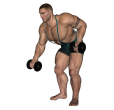 Dumbbell Row - Rotation Alternate
Dumbbell Row - Rotation Alternate
Benefits: This exercise is a strong, effective free weight back exercise for building muscle mass and size of the lats.
Purpose: This is a good exercise for increasing strength and size in the upper back.
Intermediate Traps Lats Triceps Posterior Delts Strength Dumbbell Pull Compound Gym
General Info: There are a number of muscles in the back, although the two major muscles are the lats and traps. The lats pulls the arm back and down towards the spine. The traps pull the shoulder blades back and towards the spine.
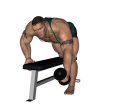 Dumbbell Row - Single Arm Inwards
Dumbbell Row - Single Arm Inwards
Benefits: This exercise is a strong, effective free weight back exercise for building muscle mass and size of the lats.
Purpose: This is a good exercise for increasing strength and size in the upper back.
Intermediate Traps Lats Triceps Posterior Delts Strength Dumbbell Flat Bench Pull Compound Gym
General Info: There are a number of muscles in the back, although the two major muscles are the lats and traps. The lats pulls the arm back and down towards the spine. The traps pull the shoulder blades back and towards the spine.
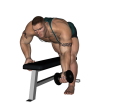 Dumbbell Row - Single Arm Rotation
Dumbbell Row - Single Arm Rotation
Benefits: This exercise is a strong, effective free weight back exercise for building muscle mass and size of the lats.
Purpose: This is a good exercise for increasing strength and size in the upper back.
Intermediate Traps Lats Triceps Posterior Delts Strength Dumbbell Flat Bench Pull Compound Gym
General Info: There are a number of muscles in the back, although the two major muscles are the lats and traps. The lats pulls the arm back and down towards the spine. The traps pull the shoulder blades back and towards the spine.
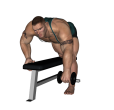 Dumbbell Row - Single Arm Rotation Variation
Dumbbell Row - Single Arm Rotation Variation
Benefits: This exercise is a strong, effective free weight back exercise for building muscle mass and size of the lats.
Purpose: This is a good exercise for increasing strength and size in the upper back.
Intermediate Traps Lats Triceps Posterior Delts Strength Dumbbell Flat Bench Pull Compound Gym
General Info: There are a number of muscles in the back, although the two major muscles are the lats and traps. The lats pulls the arm back and down towards the spine. The traps pull the shoulder blades back and towards the spine.
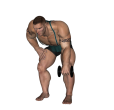 Dumbbell Row - Single Bent Knee
Dumbbell Row - Single Bent Knee
Benefits: This exercise is a strong, effective free weight back exercise for building muscle mass and size of the lats.
Purpose: This is a good exercise for increasing strength and size in the upper back.
Intermediate Traps Lats Triceps Posterior Delts Strength Dumbbell Pull Compound Gym
General Info: There are a number of muscles in the back, although the two major muscles are the lats and traps. The lats pulls the arm back and down towards the spine. The traps pull the shoulder blades back and towards the spine.
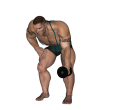 Dumbbell Row - Single Bent Knee Inwards
Dumbbell Row - Single Bent Knee Inwards
Benefits: This exercise is a strong, effective free weight back exercise for building muscle mass and size of the lats.
Purpose: This is a good exercise for increasing strength and size in the upper back.
Intermediate Traps Lats Triceps Posterior Delts Strength Dumbbell Pull Compound Gym
General Info: There are a number of muscles in the back, although the two major muscles are the lats and traps. The lats pulls the arm back and down towards the spine. The traps pull the shoulder blades back and towards the spine.
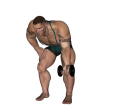 Dumbbell Row - Single Bent Knee Rotation
Dumbbell Row - Single Bent Knee Rotation
Benefits: This exercise is a strong, effective free weight back exercise for building muscle mass and size of the lats.
Purpose: This is a good exercise for increasing strength and size in the upper back.
Intermediate Traps Lats Triceps Posterior Delts Strength Dumbbell Pull Compound Gym
General Info: There are a number of muscles in the back, although the two major muscles are the lats and traps. The lats pulls the arm back and down towards the spine. The traps pull the shoulder blades back and towards the spine.
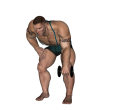 Dumbbell Row - Single Bent Knee Rotation Variation
Dumbbell Row - Single Bent Knee Rotation Variation
Benefits: This exercise is a strong, effective free weight back exercise for building muscle mass and size of the lats.
Purpose: This is a good exercise for increasing strength and size in the upper back.
Intermediate Traps Lats Triceps Posterior Delts Strength Dumbbell Pull Compound Gym
General Info: There are a number of muscles in the back, although the two major muscles are the lats and traps. The lats pulls the arm back and down towards the spine. The traps pull the shoulder blades back and towards the spine.
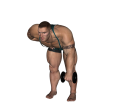 Dumbbell Row - Single Bent Over
Dumbbell Row - Single Bent Over
Benefits: This exercise is a strong, effective free weight back exercise for building muscle mass and size of the lats.
Purpose: This is a good exercise for increasing strength and size in the upper back.
Intermediate Traps Lats Triceps Posterior Delts Strength Dumbbell Pull Compound Gym
General Info: There are a number of muscles in the back, although the two major muscles are the lats and traps. The lats pulls the arm back and down towards the spine. The traps pull the shoulder blades back and towards the spine.
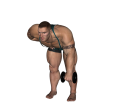 Dumbbell Row - Single Bent Over Rotation
Dumbbell Row - Single Bent Over Rotation
Benefits: This exercise is a strong, effective free weight back exercise for building muscle mass and size of the lats.
Purpose: This is a good exercise for increasing strength and size in the upper back.
Intermediate Traps Lats Triceps Posterior Delts Strength Dumbbell Pull Compound Gym
General Info: There are a number of muscles in the back, although the two major muscles are the lats and traps. The lats pulls the arm back and down towards the spine. The traps pull the shoulder blades back and towards the spine.
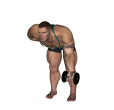 Dumbbell Row - Single Bent Over Rotation Variation
Dumbbell Row - Single Bent Over Rotation Variation
Benefits: This exercise is a strong, effective free weight back exercise for building muscle mass and size of the lats.
Purpose: This is a good exercise for increasing strength and size in the upper back.
Intermediate Traps Lats Triceps Posterior Delts Strength Dumbbell Pull Compound Gym
General Info: There are a number of muscles in the back, although the two major muscles are the lats and traps. The lats pulls the arm back and down towards the spine. The traps pull the shoulder blades back and towards the spine.
Could not find your favorite exercise in the list? Please start a discussion and post the name and the list of steps. We will try to add it as soon as we can.